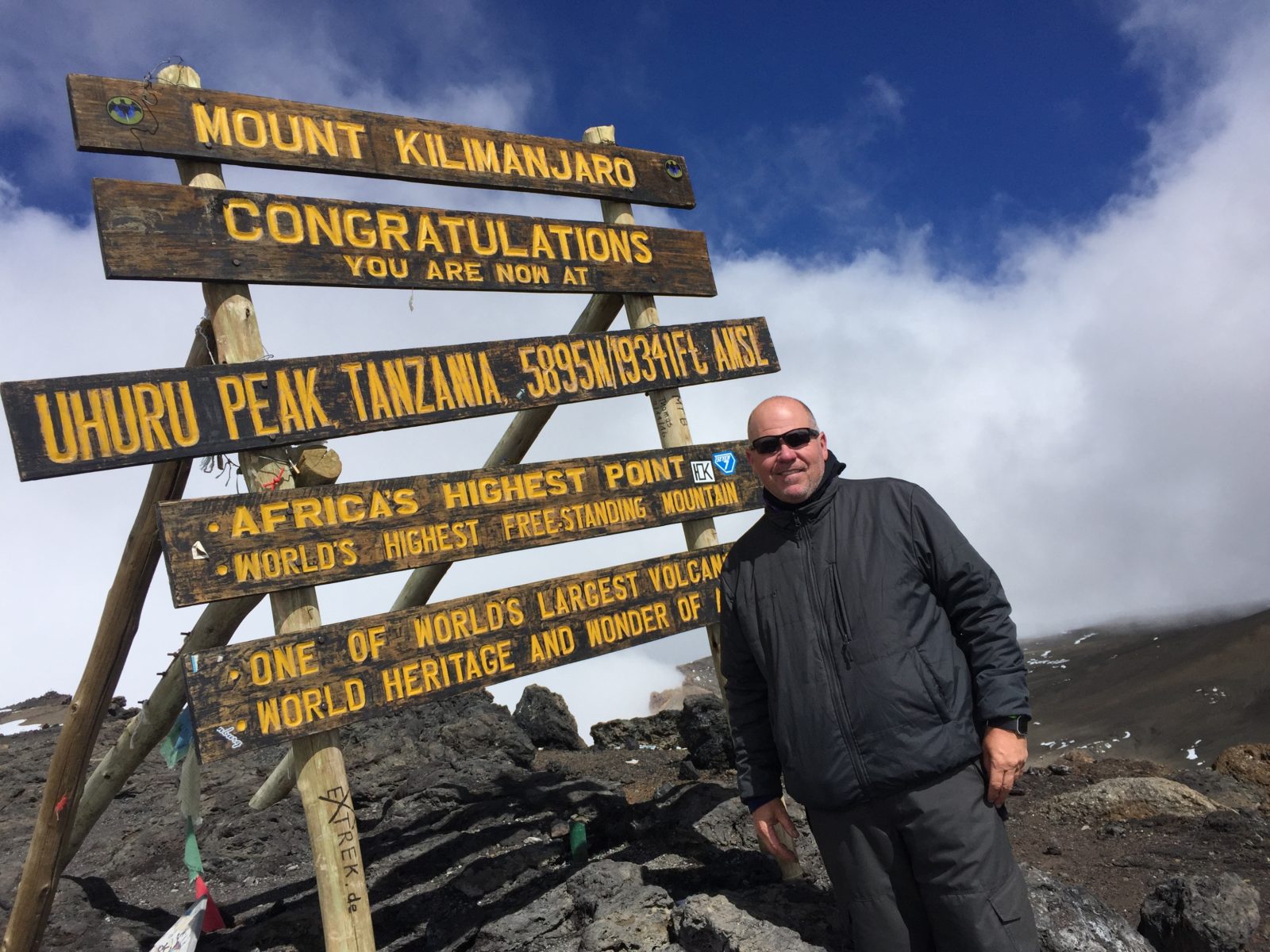"How vain is it to sit to write when you have not stood up to live." - Henry David Thoreau
I stood on the top of a mountain. Now, I'll write.
This is my story about climbing Mount Kilimanjaro in November of 2016.
Initially, I began writing this story to share my experience with my kids; Jason, Ellie, and Walter.

Now that it is written, I have decided to share it with others. Perhaps reading my story will inspire you to step outside of your comfort zone. If by the off chance you are interested in actually climbing Kilimanjaro, this story can also be used as a guide. In the end, I will outline everything you need to know in order to plan your own trip to climb Mount Kilimanjaro.
One more thing before we begin. I will explain the title of this short story at the very end.
Let’s get started.
Chapter 1
Growing up, I was never really exposed to the outdoors. I might have slept in a tent a couple of times and maybe went on a short walk in a place I would have called the woods, but I never really knew the outdoors.
In college, a fraternity brother took me and a couple of others to climb a mountain in New Mexico. I’m not sure what mountain we climbed, but it was tough. The last 300 feet before the summit was steep with lots of loose rock. We stayed in the backcountry for several days. That was my first real trip to the great outdoors and I fell in love. From that moment on, I wanted to make outdoor adventure a part of my life.
For many years after that, I would return periodically to New Mexico, primarily to ski. I would look at the mountains and dream of one day being able to live in a place like this. Around 2006 or so, my family took a vacation to Colorado. While we were on that vacation, my son Jason and I went on a rafting trip. It was only a day trip, but the thrill, the risk, and the adventure made my dreams of being an outdoorsman come back to life.
Fast-forward a few years later, and I was offered a job in Twin Falls, Idaho.
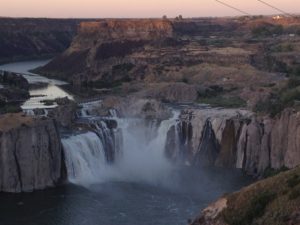
At that time, I didn’t know the difference between Idaho and Iowa. I figured Idaho was flat with cornfields. Boy was I surprised. This is a shot of Mount Baldy in Sun Valley.

Idaho had everything I ever wanted and I intended on making the most of it.
I want to pause my outdoor adventure story a moment, to give you some background on my personal journey. I am sharing this very personal information to make sure you know that there is nothing special about Chris Pruitt. This is a picture of me taken in 2016 right before one of my adventures. I'm just an ordinary average guy as Joe Walsh of the Eagles would say.

As I said earlier, part of the goal in telling this story is to inspire you. Maybe if I share what inspired me, you will gain some confidence and lose some fear when it comes to conquering big goals. So here is my brief tell-all.
In 2011 and 2012 two very significant events happened in my life. The first event was my daughter, Ellie, getting cancer. The second event was the death of my friend and boss, Geoff.
I still remember the doctor calling us to deliver the bad news about my daughter. This is a picture shot months before she was diagnosed.
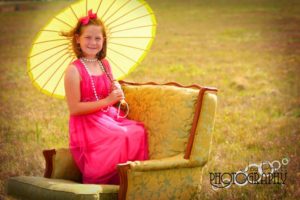
I thought to myself, “How could this be happening?” A few days earlier we had traveled over to the children’s cancer center in Boise only to rule something out. Not to confirm a diagnosis. I was scared. I have never been so scared in my life. I remember going to sleep that first day and waking up the next day hoping it was just a nightmare. It wasn’t. The following twelve months or so were by far the darkest point in my life.
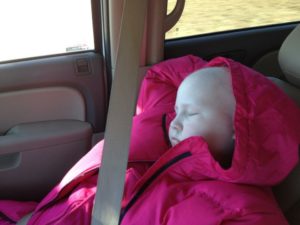
The other significant life-changing event was my boss, Geoff, suddenly dying. Geoff was one of those bigger than life type of people. When he walked into a room it was filled with his magnificent persona. He had the ability to make those around him feel valued and special. He and I developed a very good relationship in a short period of time. I was told that Geoff died of a heart attack. The heart attack happened on a Friday night. Geoff passed on Sunday, July 22nd. Coincidentally, my birthday is July 22nd. I am not going to spend much time talking about this, but I felt a lot of blame for Geoff’s death. I was pushing our company hard and had just closed a huge deal to expand the business. I miss Geoff.
So how did these two events change me? From my daughter, I learned courage. From Geoff, I learned confidence in my own ability. This was the beginning of an awakening for me. Over the next few years, I learned other valuable life lessons. I learned how to surrender absolute control. I learned how senseless it is to always delay or deny myself of real happiness. I learned to set aside fears and trust in my ability when it comes to unfamiliar situations. I learned the importance of forcing myself outside of my comfort zone. I learned to suffer and the significance suffering plays in personal development. I learned discipline and how to follow through on plans and goals. I learned the true value of life and how important it is to live your life and be healthy. Lastly, I discovered the negative impacts of being driven by money and the addiction of materialism. I will talk more about being a slave to your “stuff” later at the end of the story. Before I leave the “money” topic, I've had three adventures that opened my eyes when it comes to poverty. If you’ve never been poor or hungry, don’t be too fast to pat yourself on the back. The zip code in which you were born, the color of your skin and even what boy or girl part you have between your legs most likely played a big role in your success or lack thereof. Many will disagree with me on this. That’s okay. Everybody has a right to be wrong. Besides, these days I could give two shits what others think of my opinion.
The back-half of 2012 was tough. Business was challenging and my daughter was still in chemo.
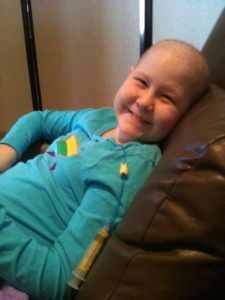
I was tired, stressed and worn slick. At that time, I weighed about 345 pounds.
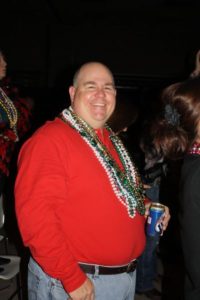
Along about November, I knew something had to give. I constantly felt like crap and had no energy. The issue was my weight and stress. I knew that if I did not change, I was going to end up dead of a heart attack like my friend Geoff. One day I just decided to do something about it. That was the day I made one of my first real commitments; get healthy and do all I can to stay healthy.
I remember my first “exercise” walk. After about ¼ of a mile, the pain in my feet and legs was almost unbearable. I ignored the pain and kept walking every day. Eventually, Later, the pain went away and my 1-mile walk turned into a 2-mile walk, and then 3-miles, and so on. Later, I started jogging. It really killed my knees. I just kept going. To help with stress, I knew I had to do something other than just work all the time. In December, I began a quest to identify things that I had never done before and then do them. My first really big “outside of the comfort zone” challenge happened on January 1, 2013. Right after Christmas Day, I heard about a polar bear challenge that was set to take place about 100-miles away. The setting was a mountain lake outside of Boise, Idaho. For those who do not know, a polar bear challenge is where you put on a bathing suit and jump into really cold water. The day before the event, a big winter storm blew in. Lots of snow and bitterly low temps. Because of the dangerous driving conditions and the sub-zero temperature, I had every reason not to go to the event. However, I woke up that morning and said to myself, “A commitment is a commitment.” I did it.
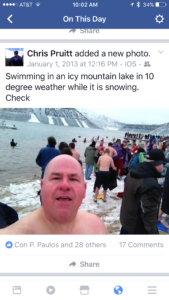
From then on, my life would continually be filled with more commitments, challenges, and firsts.
Chapter 2
At some point in early 2013, I was talking to a buddy named Charlie. Charlie said, “I know these guys that are going to climb the tallest mountain in Idaho; Mount Borah. Maybe this is something we should do?” As a side note, Charlie, along with a friend and co-worker named Michelle, are the two people who I owe the credit for getting me active. In August of 2012, they talked me into riding the short bicycle portion of a run-bike-kayak event held annually in Twin Falls. Those two probably saved my life and until now they never knew it. Charlie and Michelle, thank you.
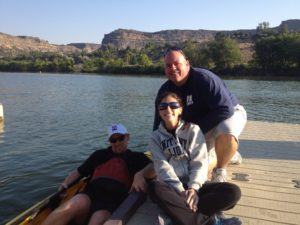
Let’s get back to climbing Borah.
Climbing Mount Borah is something many have done. What makes it a tough climb is two-fold. First, it is steep with lots of exposure. For people who aren’t into hiking or mountaineering, exposure basically means that if you slip and fall there is a good chance you will be severely injured or die. So, don’t slip. The second obstacle that makes Borah a tough mountain to climb is a ridge-line you must cross that is aptly named Chicken Out Ridge. If you go on YouTube and search “Mount Borah Chicken Out Ridge” you can watch a 14-minute video (Whenever you see a highlighted word in this story like "14-minute video" that is a hyperlink to other content like a video or website) featuring my fat ass on Borah. I say that because my friend and coworker, Ben, was behind me on the belay rope and was wearing a Go Pro camera. He videotaped some of our crossing of Chicken Out Ridge. This video does a pretty good job of showing a bit of the exposure one must face while crossing this treacherous ridge. Still to this day, it makes my stomach sink to see that video. By the way, I have yet to be able to watch the entire video. Have I mentioned yet that I’m terrified of heights? When we climbed Borah, I hired a guide. He was great. His name was Matt. What made the Mount Borah climb special was number one, I did it with my son, Jason. He, like me, has a fear of heights. Since he was heading to the Marines in a few months, I thought it would be a good test for him, as well as an experience he and I could always share. The other reason why this climb was special was that it took place on July 22, 2013. It was my 47th birthday and the 1-year mark of the passing of my friend and boss, Geoff. Making it to the summit that day reinforced my love for both adventure and the outdoors. I still smile when I think about that day. My son Jason and I still talk about it. I was hooked on mountaineering.
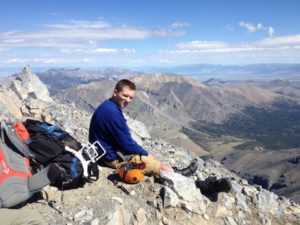
Right after I climbed Mount Borah, I started thinking about my next mountain challenge. That is when I discovered The Seven Summits and Mount Kilimanjaro.
Mount Kilimanjaro is in Africa in the country of Tanzania. The height of the mountain is 5,895 meters. If you’re like me, then meters mean nothing to you. To restate that in terms most Americans will understand, Kilimanjaro is 19,341 feet. What really drew me to the mountain is that Kilimanjaro is one of the Seven Summits or seven highest points on each continent. Although Kili is very tall, it is a relatively safe climb and does not take a lot of technical climbing skills. By the way, once you stand on the summit of a mountain, you are officially cool enough to refer to it by a nickname like Kili. Just kidding; kind of. So, armed with this info I added “Climb Kilimanjaro” to The List. Oh yeah, The List (Hyperlink). I will talk more about The List later in the story, so sit tight on that one.
“Climb Kilimanjaro” would hang-out on The List for quite a while. I would think about Kili often, but I made no real plans to climb. I considered doing it in May of 2015, but life got in the way. In August of 2015, I was at a business convention when I heard a lady speak about climbing Kilimanjaro. It reminded me of The List. That afternoon, I was walking around Austin with a buddy named Britt and we talked about the speaker. Britt knew about The List. I told Britt that climbing Kilimanjaro was on The List and that it was something that I would one day complete. I think he thought I was kidding. For the next few weeks, I thought about that mountain and the challenge. On October 22nd of 2015, I decided I was going to do it. I announced my plans to the world on Facebook that day.
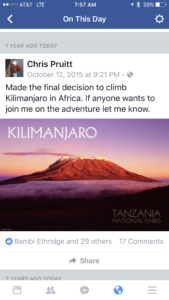
At this point, my research began.
So how does a person with little mountaineering experience go about climbing one of the Seven Summits? Do what I always do. Consult the Google!
Chapter 3
For the next 10-weeks, I read everything I could find on climbing the mountain and traveling to Africa. It was on January 1st of 2016, that I felt like I was armed with enough information to make an actual plan to accomplish my goal. I methodically thought through steps of getting to Tanzania, going up and down Kili, and then returning safely back to the States. The result was a plan consisting of 7 items: get a passport, identify time I could be away from family and work, find a guide service, get some trekking dates, figure out the cost, save the money and then GO! Things like acquiring more mountaineering experience and training for the climb did not make the initial plan. Now it was time to start checking off items on this list. Here is a picture of the list put I together.
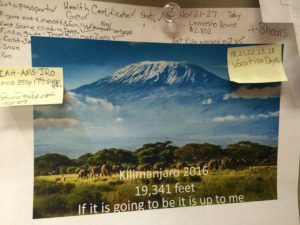
This list hung beside my desk in my office for the next eleven and half months. It was a daily reminder of something that I had to look forward to. It was also a reminder of the challenge to which I had made a commitment.
Step 1 – Get a passport. To this point in my life, my only travel out of the country had been to Mexico. That was many years ago when a passport was not required. On the 6th of January, I went down to the Twin Falls, Idaho, Main Post Office and picked up the passport paperwork. I went to Walgreens and had some passport photos shot. I completed the paperwork in my car and returned to the post office and paid the fee so I could submit the paperwork that same day. About 3 weeks later, my passport arrived in the mail. I was now cleared to leave the country. Step one was complete, and I was a little closer to realizing my goal. From this point forward, Chris Pruitt was no longer confined to the borders of the USA. My new home address was Planet Earth because I had a passport.
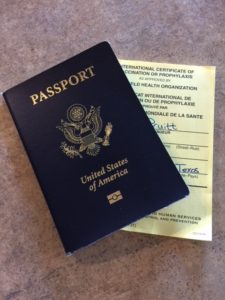
All of the rest of the steps kind of run together. I can’t remember exactly when I first talked to my family about what I wanted to do. I don’t think they believed that I was serious about climbing a mountain in Africa. Honestly, I was not completely sure that I could really pull this off. Why's that? Well, my work and personal schedule are crazy. In July of 2015, I left my job at the TV station in Twin Falls and went back to work for my old company. There's a whole backstory behind this, but I'm saving that for another book. My new position has me working in Waco, Texas. Because of a lot of reasons, my family remained living in Idaho while I work 2,000 miles away in Texas. In Texas, I do what I have always done; solve problems and fix things. The Waco job is what my boss, Julie, calls a heavy lift. I do make it home to see my family every three weeks or so. It’s tough, and I miss my kids. I try to put a positive spin on the situation by reminding myself how fortunate I am to live in Texas and yet be able to take an Idaho vacation every month. It still gets lonely. I miss my kids. Oh crap, I got off on a sidetrack again. Sorry. Back to the story.
To ascend Kilimanjaro, you must climb with a registered guide. You can’t go it alone, nor should you. I did a lot of shopping and I narrowed my guide options down to two outfits. Both seemed very reputable and had great reviews on the web. They were not the cheapest, but they were not the most expensive. I learned a long time ago that cheap ain’t good, and good ain’t cheap. You get what you pay for. What ultimately made me decide to go with the company I chose was threefold: they were responsive to my questions (and I had a lot), they had an actual office in Africa, and they had a route and dates that I thought offered me both a challenge and the best chance to summit. The cost of their service was $2,800. So what does this get me? Basically, everything that would be needed while I was in the country. First, it included my transfers to and from the airport, Kilimanjaro International (airport code JRO). It also included my hotel accommodations before and after the climb. Most importantly, it got me competent guiding to get me safely up and down the mountain. Notice that I said up AND down. When you climb mountains, you learn quickly that when you reach the summit your work is only halfway complete. As my guide on Mount Borah shared, UP is optional, but DOWN is mandatory. With my guide service now arranged, all I had to do was assemble the items on a provided gear or kit list, and then show up for my flight. Oh yeah, I almost forgot something. I had to do some training too. Actually, a lot of training. Here is a picture of the training-countdown calendar that I hung in my office.

I will talk about this later, but to climb tall mountains means you need to have good physical conditioning. I had a lot of work to do. Oh, and more thing. As any alpinist will tell you, you must also get comfortable with suffering. Alpinist, by the way, is just another name for somebody who climbs mountains.
Chapter 4
Over the next couple of weeks, I had conversations with my family and my boss. I told them about the trip and the dates I had selected. Once I had the okay from both, I still didn't pull the trigger because I wasn't completely comfortable. Why? I still had a lot of doubts and fears. Deep down, I truly didn’t believe that I could really pull this off. A lack of confidence and fear was blocking my path.
At the beginning of October, I was at my home in Idaho. We had taken one of our foreign exchange students who live with us to get a haircut. I was waiting in the car with my family while he got his haircut. I brought up the subject of climbing Kilimanjaro and my daughter said, “Dad, you need to quit talking about it and just go ahead and do it.” My daughter, Ellie, is so incredibly special. She is my rock when it comes to courage. A kick in the ass from her was all I needed to pull the trigger. Right then, while setting in the car at the barber shop, I pulled out my smartphone, clicked on the Delta app, booked my ticket to Kilimanjaro Airport and sent a note to the guide service telling them to send me an invoice. I now had skin in the game and I was now committed.
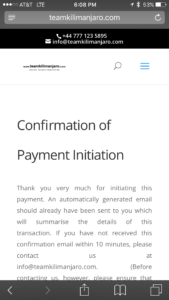
Even though I had a ticket to fly and a reserved space with the guide company, I still had much work to do. Initially, I thought all you needed to travel to a foreign country was a passport. Not so quick. In addition to a passport, for most countries, you also need a Visa. I consulted with "The Google" on how to get a Tanzanian Visa. Sure, I could have applied and received a visa when I arrived in the country, but on the websites, I read it said that there is always a chance you could get denied. To get a visa, I had to send my passport and $100 to the Tanzanian Embassy in Washington, D.C. I was a little nervous about sending my passport off in the mail, but I followed the instructions and in about a week I had my passport and visa in hand.
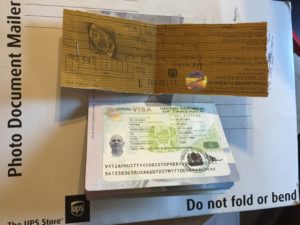
In case you are considering going to Tanzania, just Google Tanzania Visa. You will find a link to their embassy and follow the instructions. I sent my application, a check for payment, pre-paid return envelope and passport off using UPS. I did pay extra for the package tracking.
In order to travel to Africa, you will need some vaccinations. Because it had been years since I had received any shots, I got a ton of them. The first visit I got 5 shots. On the second visit, I believe I only had one, but it might have been two. I hate needles.
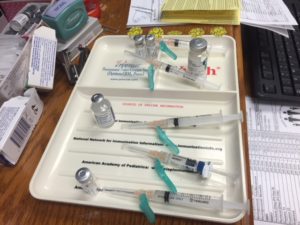
The last requirement I had to fulfill was getting all of the gear outlined on the gear list. Another name for your gear list is Kit. There are many Kilimanjaro Kit List on the internet. I crosschecked and compared the lists on the Internet and came up with a list I thought would be best. I have included my Kit at the end of this book. Since I have done some climbing before, including multi-day outdoor trips, I kind of knew what is truly essential and needed, and what is overkill. Still, I took too much with me. As an option, most guides have a service where you rent a kit from them. This might be good for some, but since I already had most of the gear that was needed, I passed on their offer. When it comes to outdoor gear, I think the most important thing is staying warm and dry. Whoa. Hold on. Let me back up because there is something way more important than warm and dry because if you screw this up your trip will suck.
Footwear. If you are hiking, the absolute most important piece of gear is comfortable and well broken-in hiking boots. Here is a shot of the boots I wore on Kilimanjaro. As a side note, I gave my boots after the climb to my guide so he could give them to one of the porters.
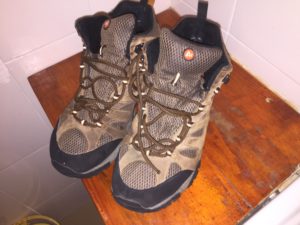
When I climbed Kili, it was in November and it was very wet. My boots were not completely waterproof, so I ScotchGarded the crap out of them. For socks, I always use a two-sock system when hiking that consists of a silk sock liner and a thick wool hiking sock. I like the brand SmartWool, but REI makes awesome socks too. I used a medium weight sock each day on Kili except for summit night. For summit night, I used an extra thick sock for warmth. Why am I making such a big deal out of the boots and socks? One of the most common issues that screw up a great hike is a blister. One of the guys I climbed with on Kilimanjaro, Russ, was almost taken out by blisters.
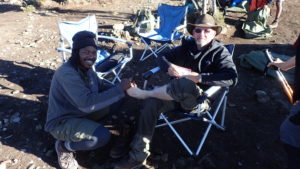
Here is everything you ever needed to know about blisters. You need three elements to create a blister; heat, moisture, and friction. Remove one of those elements and you will not get a blister. Although it was cold while I climbed Kili, I still created tons of heat inside of my somewhat waterproof hiking boots. Ding! Heat. One present element for blister creation. Despite having somewhat waterproof boots, the rain we experienced was at times very heavy. Because of this, I did have moisture in my boots. Moisture in your boots is almost unavoidable. Ding Ding! Moisture. There was necessary element number two for blister creation. However, because I wore boots that were broken in and used good, high-quality wool socks with silk liners, there was no friction. No friction meant no blisters despite the presence of both heat and moisture. One more word on blisters; to pop or not to pop? That is a question left for someone else. Let it be known that I went up and down Kilimanjaro without getting a single blister. Now back to keeping warm and dry.
There is so much great gear on the market today there is no need to not be both warm and dry on your adventure. If you want to explore your options, I recommend a trip to an outdoor store, like REI. In one visit you can have everything you need. You can also go online and shop with online retailers like Backcountry. Another online option is to buy used gear on eBay.
Keeping warm on Kilimanjaro. It really sucks to be cold. Why do it if you don't have to. Kilimanjaro is located close to the equator. However, it was cold each night. Even on night one, when we were still in the rainforest, both of the guys I climbed with said they were cold. As for me, I was nice and comfortable. My sleeping bag is an REI Arctic Pod. I also used a Thermarest liner they call a thermal sleeve. As I mentioned earlier, at the back of this book is my complete Kit List as well as advice on things like tipping your guides, and little ins and outs like how much and what type of cash to carry. For example, you can’t use US currency printed before 2006 in Tanzania. Details to follow.
The dates I had chosen to climb was November 21-27. The route I chose was the TK Lemosho. TK stands for Team Kilimanjaro. I flew on KLM and my ticket cost about $950. I booked my flight out of Houston for the 17th. I went out of Houston because I wanted to minimize the number of plane changes and connections. After all, if I got to Africa and my luggage didn’t, I would be screwed. As I mentioned earlier, the most important and irreplaceable piece of gear you can have on a hiking trip is your boots. I wore them on the plane. I recommend you do the same if you are on a hiking adventure that requires a flight. Also, pack your irreplaceable and very important items in a carry-on. Baggage handlers make mistakes. I also recommend shooting a picture of your bags with your mobile device and keeping it with you should your bags get lost or damaged.

Chapter 5
It was Thursday, November 17th. The flight over to Africa went through Amsterdam. About 10:30 am, I left Waco headed for the airport in Houston. Here is a link to a video I shot as I traveled. The drive over takes less than 3-hours. It was non-eventful and easy. I parked at the IAH economy parking lot.

I had brought along two sets of keys with me. I put one set of keys in my carry bag, and the other set inside the door to the gas tank of my truck. I then shot a picture of where I parked and sent a text to my family telling them exactly where I had parked along with the picture. I also told them the keys to my truck was inside the gas tank door. I did this as a precaution. In the event something went wrong, my thought was that they could fly to Houston and be able to drive my truck. Since I am talking about actions I took prior to my trip, another precaution I took was making sure I documented everything concerning my family’s finances, my insurance policies, my will and even where I keep the detailed instructions on how to take down and tow my RV. Because I have a lifestyle that is a bit "out there" and at times involves exposure to personal injury, right after I moved to Waco I wrote a personal letter to my family. Whenever I head out on one of my crazy adventures, I get it out of the file cabinet where I keep it, and put it, along with my insurance policy on my desk. The content of the letter is private, but it begins with, “If you are reading this letter, then something has gone terribly wrong.” Most of the time I give my family a heads-up that I am about to do something stupid. Sometimes, like when I went skydiving or enrolled in a bull riding school, I don't say anything to them until immediately before or after I am done with the adventure.
Since I am talking about insurance, you should buy special insurance for a trip to climb Kilimanjaro. I will talk about this at the back of this book. And so I won't forget, you need to make sure the policy you buy covers climbing mountains up to 6,000 meters. In F's, that's 19,685 feet.
Finally, I was inside the terminal at the airport.

My flight out of Houston was on a 747.

We started boarding about 3:20 pm for the 4:00 pm flight. For the flight over, I had packed some snacks in my carry-on bag. I have always enjoyed Fritos and Bean Dip. The flavor combination suits my palate. I fly a lot, so several years ago I went through a screening process that allows me to get in what is called the TSA Pre-Check lane. Being a pro at going through airport security, I was surprised when they said they needed to check my bag after it went through the machine. The TSA agent looked through my bag and then told me that they were going to need to confiscate my bean dip.
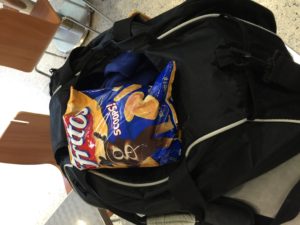
WTF! I thought the lady was joking, but she was serious. Turns out the size I bought was too large to go in a carry-on bag. I challenged and even begged a little, but there would be no bending of the rules. As the lady was zipping my bag up I said, “I figured it out. TSA. It stands for taking snacks away.” She kind of laughed and thought it was funny. So did I. Bitch still kept my bean dip...
As we were waiting to board the flight, emergency alarms started going off in the airport terminal. Instead of making our way to the exit, everyone just stood there in line like nothing was happening. Since I had never traveled internationally before, I was a nervous wreck and the blaring alarms made it worse. I had been told by many about the importance of not losing my passport. I bet I checked the pocket where my passport was located 50 times. I also double checked to make sure I had my shot record as well. My Tanzanian Visa was stamped inside of my passport, so it was safe.
A flight to Amsterdam takes about 10-hours. The longest I had ever been on a plane to this point in my life was 6-hours to Hawaii. I hate flying. I also hate sitting. We left Houston right on time at 4:00 pm.
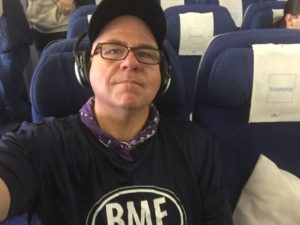
As the wheels of the plane left the ground, I experienced mixed emotions. My seat was located in the Economy section of the plane. Although I booked with Delta, the flight was operated by KLM. On the flight over, I got free booze and two good meals.

We had a lot of turbulence as we crossed the Atlantic. Did I mention I really hate to fly? To combat the nervousness, I had more booze. With 4 hours and 3 minutes still left on my flight, I got up and walked around the plane because my back was killing me. Several years ago, I started using a stand-up desk. Sitting now kills my tailbone. Finally, the plane landed. It was early morning when we landed in Amsterdam. I was relieved to be back on the ground. Here is a short video I made as I got off of the plane.
When I got off of the plane in Amsterdam, I had a little panic moment. I didn’t know if I needed to go and get my luggage and go through Customs, or if I just went on to my plane. A very nice flight attendant got me all lined out. Before I had left the U.S., I had my mobile phone unlocked so that I could buy a SIM card in Africa. In Amsterdam, of course, my AT&T service would not work. However, they did have free wi-fi in the airport, so I played around on the web while on my 3-hour layover.
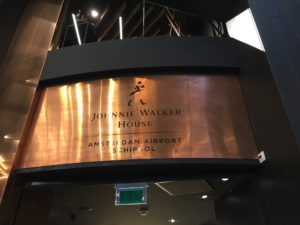
By the way, the airport in Amsterdam is very cool and worth exploring.
It came time to board the flight out of Amsterdam.
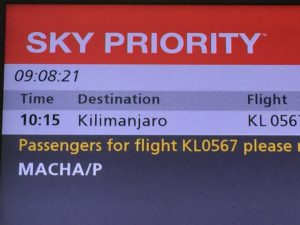
I was really tired. In fact, I was so tired I was delirious. Luckily, there was an open seat on the plane between me and the other person on my row. That made for a nice comfortable 10-hour flight to Kilimanjaro Airport.
Because I snore, I hate to fall asleep when I fly. Usually, I never fall asleep on a plane. I think we were barely off of the ground and I was fast asleep. I slept for about 3-hours. When I woke up, I could tell by the look on the people’s face around me I had been snoring. You know what? Maybe they should have thought ahead and brought along some earplugs like I did. Oh yeah, and European people really do need to learn the importance of deodorant. Maybe that is why my Dad always said foreign countries are dirty, nasty, stinking and filthy. Of course, the only time he was ever in a foreign country was while he was in a war. Oooops. Back to the story.
About 7 hours into the flight, I looked out the window of the plane and I saw the reflection of a river reaching as far as my eye could see. I looked at the flight track system on my seat entertainment console and although it did not identify the river, it did show the name of the city below the plane; Atbara. I wondered if the river I saw out the window was the Nile. Sure enough, I later checked it out and it was. A few minutes later, I got to see the sunset on Africa for the very first time in my life. I had several thoughts as we flew to our destination. At some point, I started thinking about the amount of time that I spend by myself nowadays. As I looked around the plane, most people were there with someone else. The lady who drove me on the shuttle from the parking lot in Houston to the terminal asked me where I was going. I told her, “Africa.” I assume, since I was by myself she said, “For work?” I said, “No just for fun.” She then said, “And you’re going by yourself?” I just smiled but didn’t reply. That part of my life is complicated, and for now, personal.
Like I said earlier, I spend most of my time now alone. I’ve gotten very good at being alone. Sometimes, I think too good. I do get lonely, but it’s only when I think about being lonely. Staying busy at work helps me not think about it, so I stay busy.
I think the time change and the lack of sleep were messing with my mind. I had some very odd thoughts as I flew along.
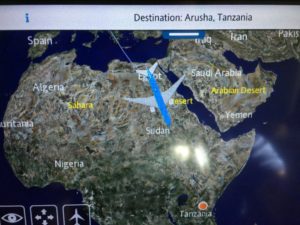
We all know the terrible and unspeakable things that take place daily in parts of Africa. Africa is a country where death, disease, war, famine and even genocide are common. As I flew along sipping Cognac watching a movie, I couldn’t help but feel a bit of guilt. I thought about all of the bad things that were most likely going on at that moment just 6-miles below me. What if a young child, who was going through a horrific event looked up at the sky and saw my plane and suddenly found hope, but then decided to give up as the plane disappeared from sight? The thought brought tears to my eyes. At that point, I knew the lack of sleep and fatigue was playing tricks with my mind.
Chapter 6
We landed at Kilimanjaro around 8:30 pm at night. I was ready to get out of that airplane. Kilimanjaro Airport does not have jetways for getting off the plane. They just roll some stairs up to the plane. The second I got off the plane, the full gravity of what I was about to do really hit me. Here is a link to a short video I shot as I walked away from the plane. I was really in Africa about to climb a very tall mountain. This crazy idea I had well over a year ago is really going to happen. With the plane still screaming in the background, I walked toward some official looking people who were checking documents. I pulled out my passport, but they were wanting to see my boarding pass from the flight I just got off. I thought this was kind of crazy, but when in Africa! From there I went inside the terminal.
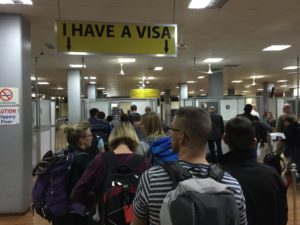
There were two big signs. One said “I Have a Visa” and the other said, “If You Need a Visa”. I had my visa, so I walked up and was about 4th in the If You Have A Visa line. The line for the folks that did not have a Visa had 90% of the people who had just got off of the 777 we flew in on. Here is a video of what this area of the airport looked like. When it was my turn to go up to the booth, I handed the officer my passport, shot record and a form they asked us to fill out on the plane.
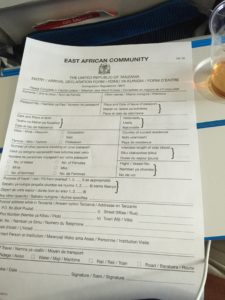
They took my picture and then electronically fingerprinted me. I was through this part of entering the country in about 10-minutes. I then proceeded over to the baggage claim area. I instantly found my luggage and headed for the doorway. As I approached the doorway, a lady dressed in bright African looking clothing said something to me. I figured she was either a greeter or just somebody trying to get me to use their taxi service outside so I smiled politely, bowed and said “No Thank You” and walked on. About two steps later a very official guy in a uniform stepped in front of me and said “What are you doing? You cannot leave the airport without having your luggage processed through customs!” Crap! In the country for fifteen minutes and I am already in trouble. I apologized and bowed to him as well. He just gave me a look of disgust. About then I thought to myself, “What the hell is up with the bowing, dumb ass. Cut that shit out. You're in Africa, not China!” Next, I walked over to this area that has a small sign saying "Customs." The only thing in “Customs” was one woman and a very old luggage x-ray machine. This machine was so old I really don’t think it actually worked. The lady sitting behind the machine was probably watching a movie on the monitor. None the less, I pushed my bags through the machine and collected them on the other side. The conveyor system didn't work so well.
When I walked out of the airport, I saw a guy holding a sign with my name. I walked over to him and we exchanged greetings. His name was Jamal. Jamal took part of my luggage and we went to his vehicle. It was a Toyota Land Cruiser safari truck. This was the first of many reminders that I was no longer in the USA. After we loaded the bags, he told me it was an hour drive to Arusha, the city where my room was located. He asked if I needed to use the washroom. I told him, no, but I could stand to take a leak though. He said, “Yes, the washroom is over there.” They call the bathroom the washroom in Africa, I guess. When I walked into the bathroom, I mean washroom, everything looked normal except in the place where there should have been a toilet there was a hole in the floor. There was also a bucket with some water and a scrubbing brush in the corner. This was indicator number 2, figuratively and literally, that I was no longer in the USA. Of course, I had to shoot a picture of it.
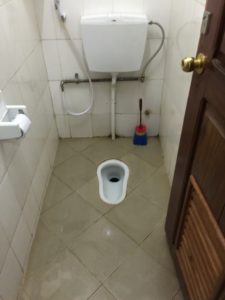
I remember while I was taking a leak that I laughed wondering if the bucket of water and brush beside the hole in the floor was for the floor or the ass; or maybe both. Right then, I knew I loved Africa. Why? I have no idea…
When I got back to the truck, my driver and I set off for the city of Arusha. Arusha is about an hour and a half South of Kilimanjaro Airport. It sits at the base of another famous mountain, Mount Meru. The population of Arusha is over 500,000. It’s a very big city.
The first thing that was immediately noticeable as we drove over to Arusha is that the steering wheel in our vehicle is on the right side of the car and not the left. This is of course because you drive on the left side of the road in Tanzania. Although it was night, I could see outlines of buildings. By the light of the headlights, I got my first glimpse of the poverty in Africa. The road was maintained well in some parts, but there were other areas that were torn up and appeared to be under construction. As we drove down the highway, we passed many people walking and others who were riding small cheap motorcycles. As we got closer to town, the number of motorcycles increased. These motorcycles, mostly carrying two people, were buzzing in an out of traffic in a very haphazard way. The next day I would find out that motorcycles are a big part of the public transit system.
We had been in what I call "town" for only a few minutes when the driver slowed and turned left. I noticed the name of the street was Serengeti. We went about 200 yards, then turned left, and proceeded through a guarded gate. I then saw the sign, Outpost Lodge. This is where I would be staying the next 2 days. I was met by a very nice young man who introduced himself as Luka. I immediately thought of the song by Suzanne Vega. I used to make fun of that song. Anyway, Luka escorted me up to the front desk. Although the front desk was under roof, it was all open air. It was dark, so I couldn’t see much. Luka welcomed me and gave me info on things like checkout time, breakfast time and keeping my windows shut at night to keep the monkeys out. Monkeys out! They’re going to eat my face! Again I thought, I’m not in the USA anymore. By the way, for about a month before leaving on this trip I had a reoccurring and very real nightmare about being attacked by lions.
After I stepped away from the counter, two guys already had my luggage and were ready to take me to my room. At the Outpost, the ground vegetation is very tropical. I was told when I booked my trip that the Outpost was “Traditional” and somewhat meager accommodations. I was thinking Eddie Murphy and the movie Coming to America, but when the door opened to my room I was surprised. The room was sparkling clean and had everything I needed. Two full-size beds, a chair, a desk and a very nice bathroom. The room was not air-conditioned, but as I soon discovered, it was not needed as the nights in Arusha are very cool. One thing that was unique was that both beds were completely enclosed in mosquito netting.
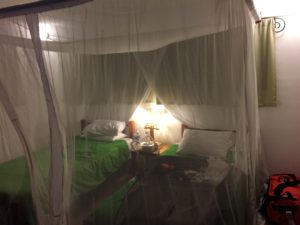
There were instructions on the desk in the room about how to use the mosquito netting. Also, they use a different power connection in Tanzania. I had come prepared with a power converter. After fumbling around a few minutes, I figured it all out and had everything plugged in. When I sleep, I use a Bi-pap machine because I have Sleep Apnea. I was happy when I plugged my machine in and it fired up. At this point, I was exhausted. I took a few minutes to situate the room and my luggage and collapsed into bed. I slept hard until about 4:00 am. When I woke up, I was having difficulty breathing. It took me about 30 or 40 seconds to figure out that my Bi-pap machine was not working. I took off the mask and discovered the electricity was out. I was so tired I said screw it. I rolled over and went back to sleep. That night I slept hard and good.
Chapter 7
I woke up about 8:00 am feeling refreshed. I had successfully got rid of the daze I was in due to the flight. I took a shower, being very careful not to let any water get in my mouth or up my nose. I had read that the public water in Arusha is not good. I then got dressed and stepped out into the African sunlight for the first time. Again, I saw all of the tropical plants on the grounds as I crossed the courtyard.
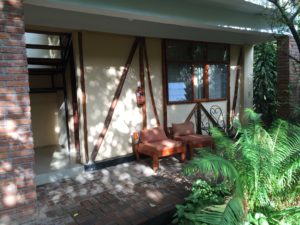
On the other side of the compound was the restaurant. A free breakfast each day was included with my stay at The Outpost. The breakfast consisted of a two egg omelet made with brown eggs, toast, fresh fruit and instant coffee. Yes, instant coffee. The person working in the service area of the restaurant assured me the hot water in the container was safe to drink. I needed a cup of coffee. I sucked-up the fact that the coffee was instant and I was possibly using contaminated water while I prepared my cup of coffee. To my surprise, their instant coffee was extremely rich and flavorful. I loved it! After breakfast, I was walking back to my room when Luka, the gentleman from the night before, greeted me. I said, “Good morning,” and again bowed (Why the hell am I bowing to people when I talk. I’m a freaking idiot.) Luka asked if I had any plans. I told him, no, that I wanted to get settled in and check all of my gear. He told me that he had just got off of work and asked if I was interested in having him show me the town. I told him to give me an hour, and I would meet him back in the courtyard. Then we would go to town.
I returned to my room and checked all of my gear. I wanted to be extra sure I did not leave something behind. About an hour later, I returned to the courtyard. Sure enough, Luka was waiting. The walk to town was a mile or less. The street was packed with vehicles. This was my first real glimpse of the lunacy that is driving in Arusha. The sidewalks were filled with people too. As we walked to town, Luka told me he was a member of the Maasai tribe. The Maasai people are indigenous to northern Tanzania and Kenya. They are cattle and goat herders.
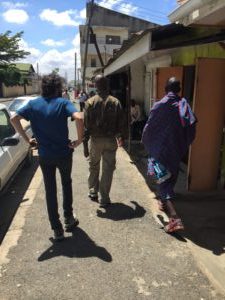
Again, I thought of the movie Coming to America. The number of livestock they have is indicative of their wealth. When in the field working, they wear a red robe like garment called a Suntan. They are known as fierce warriors. Real BMF’s. At the beginning of the town of Arusha is a traffic roundabout circle that has a clock tower in its center.
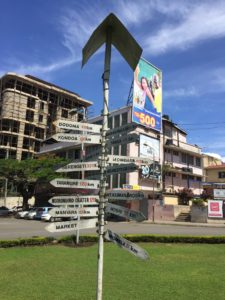
Here is a link to a video of the roundabout. Luka told me that the clock tower is situated at the midpoint between Cairo and Cape Town. I don’t know if this is true or not, but he convinced me it was. Once we crossed the street from the traffic circle, I was immediately accosted by street vendors selling local goods. Quickly I figured out that Africa was just like Mexico. The street is full of people trying to sell you things. And like Mexico, it basically consisted of about 14 different items. Whenever the swarm of vendors would get too thick around me, Luka would give them a look and a hand gesture and they would immediately leave me alone. I told Luka that I needed to buy a SIM card for my phone. We crossed the street and he took me over to a store that had posters of phones in the window. The company that does most of the cellular business in Tanzania is called Airtel. With Luka’s help, I told the guy at the store what I wanted. He then told me that the cost was 155,000 schillings. I had no idea what the exchange rate was, so Luka helped me and explained it was about $70 USD. The store would only take schillings, so we went next door to get some currency converted. I exchanged about $100 USD and returned to the store. The guy behind the counter took my phone, programmed the SIM Card and inserted it into my phone. For $70 USD I basically got unlimited texting, unlimited data and enough minutes to make one, yes, one phone call. It was no big deal because if I had data, I could use the Internet to make a phone call.
On the way back, Luka took me to a store where the sell Tanzanite stones. I told Luka that I had no one to buy jewelry for. We went in any way because I think the locals get a kickback if they bring in a tourist. A very nice guy showed me around a small museum and explained the mining of Tanzanite. When we left, I told Luka I wanted to pick-up a couple of small gifts for people back home. He took me to a small storefront that said, Maasai Gift Shop Cooperative. There were two very nice men working inside. Upon entering they told me that everything in the store was made by the Maasai people and that all proceeds were given back to the people in their village. Since everything in the store was basically the same as the 14 items that were being peddled by the street people, I am sure these guys were full of crap. However, the nice thing was that it was a calm relaxed atmosphere and I was able to browse and shop. After I made my selection, the guys in the store started doing some fuzzy math as they totaled me out. They attempted to screw me over, so I reminded them of the prices they had quoted for each item. Had they been honest, I would have just paid them. But because they had tried to stick it to me, now they were going to have to negotiate. Game on! When everything was all said and done, I paid about half of what they had originally quoted. From that, I learned that everything in Arusha is a negotiation.
We left the store and walked back to the lodge. For the remainder of the day, I just sat around in my room and napped while watching TV. About 7 pm, I walked over to the restaurant for dinner. I had a traditional African meal. It was pieces of meat in a curry sauce that had hints of nutmeg and a side of white rice.
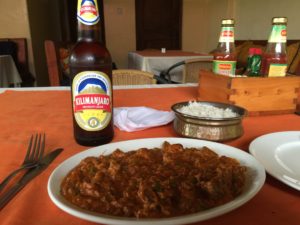
I would soon find out that just about everything you ate in Tanzania had curry, nutmeg and sometimes ginger. The dish was great, but the seasoning would get old real quick. I washed it all down with a Kilimanjaro beer and a Serengeti beer. Both beers tasted great.
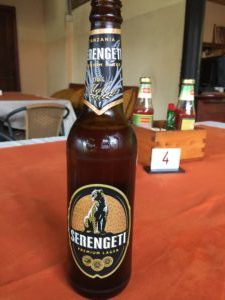
With a little bit of alcohol on board, falling asleep that night was not a problem.
Chapter 8
I awoke the next morning about 7:30 am and immediately got dressed and went to eat breakfast. I had the same breakfast this morning as I had the previous morning, only today they had something they called "sausage" on the menu. Okay, what they call sausage in Africa, we call hotdog. I ate one, and it was ok. A hotdog. While I was eating my breakfast, I noticed a man in his 50’s talking to another guy that appeared to be in his late 20’s. They were talking about climbing Kilimanjaro. I knew that there would be two other people joining me on the climb, so perhaps this was the two guys. I made eye contact with them and the younger one, Chava, said, “By any chance, you wouldn’t happen to be Chris Pruitt would you?” I said, “Yes I am.” It was at that point I met the two people whom I would spend the next several days jointly testing our mettle against the mountain. I picked up my breakfast plate and coffee and moved over to their table to join them. As I mentioned earlier, the younger guy was named Chava. The guy that was closer to my age was named Russell.
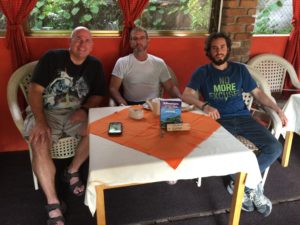
Chava is a young guy who is climbing Kili to celebrate his life. A few years ago, Chava was walking down a street when a large piece of glass that was being installed on a high-rise building fell and hit him in the head. It took him a long time to recover from his injuries. Attempting to climb Kili is his way to celebrate recovery. He was inspired to climb Kili by a motivational speaker. I wondered if it was the same lady that I spoke of earlier. I asked Chava about his climbing and outdoors experience and that is when he told me he had none. Chava later confessed to having never even slept in a tent before. Although Chava had no outdoor or mountaineering experience, he was fit, had a great mental mindset and had invested in good gear. By the way, Chava is from Los Angeles and is a marketing guy for Coors Miller Beer.
Russel is a Texan with a capital T. His business is construction. He lives on a ranch in Poteet, Texas, which is right outside of San Antonio. Russ’ work has taken him all over the world. Many of the places where he has worked are war zones like Afghanistan and Iraq. He has lots of great stories. I am not quite sure why Russ had come to climb Kili, but I think it had something to do with his wife who had passed away a little over a year ago. Over the next few days, he would tell me quite a few stories about his wife. I could tell that he loved her and missed her. Recently, in a search for companionship, he had tried an online dating website. He said that after a few weeks he took his profile down because the women he was meeting seemed to all be psychos. After he took his profile down, he got a note from the service saying he still had a few days remaining on his subscription so he put it back up. That is when he met Victoria. Although Victoria is several years younger than Russ, she too is a widower. When Russ was not talking about his wife that had passed away, he was talking about Victoria. He said the nice thing about their relationship is that since they were both widows, each of them knew and understood the importance of their past relationships. Widows? That's an odd word.
We really didn't talk much about me or my past because I kept peppering them with questions. Basically, all I really shared with them about me was that I worked at a TV station, had climbed a few mountains and that I lived in Idaho and worked in Texas. I also told them about my daughter, Ellie, and her having cancer.
When we finished breakfast, they said they wanted to go to town. I told them about having one of the guys from the hotel escort us over and they said they had already been told not to go to town without an escort. We all agreed that we would meet back up in the courtyard in about 30-minutes and go to town.
Our escort that day was another member of the Maasai tribe. His name is Isaac. We spent about 4 hours with Isaac cruising all over town. We went to the main central market in Arusha as well as a very cool museum on the edge of town. About 3p, we headed back to the hotel. Here are some pictures from our day in Arusha.
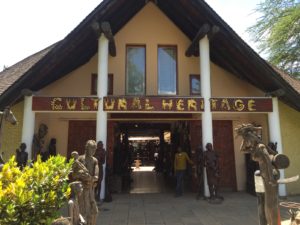

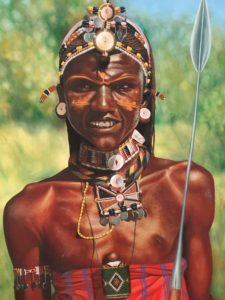

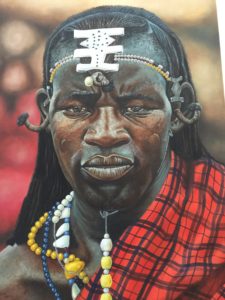
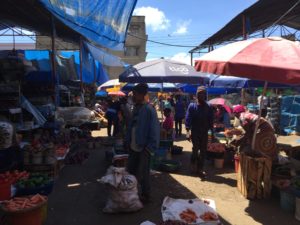
When we got back, we all had a message waiting from our guide service. The message was that our main guide would arrive at the lodge at 6:00 pm to brief us on our trip and check out our gear. Around 6:00 pm, I noticed a very pleasant looking guy walking into the lodge courtyard. He was small in stature, but something told me this was our guide. I asked him if he was a guide there to meet his climbers. Sure enough, my instincts were correct.
The man introduced himself. I said, “Hello. I’m Chris.” This time I did not bow. I could not understand his last name, but his first name was Nick.

Nick asked me if I knew where the other two guys were. I pointed to the restaurant. Together we walked over to the restaurant area and I introduced Nick to Russ and Chava. Nick would spend the next 30 to 45 minutes outlining everything that would take place over the next seven days. He talked about the route, the crew, the food, the way a normal day would work, what we could expect from him and what he expected from us. Nick seemed to have one goal in mind and that was getting us to the top and back down in a safe manner. Nick really helped to put some of my fears at ease. After we were done talking, Nick wanted to check out our gear. He also had to give Russ and Chava some gear they had rented like sleeping bags and rain suits. After we concluded meeting with Nick, the three of us met back up in the restaurant and had dinner. Right after dinner, we all went back to our respective rooms because in the morning at 7:30 am the adventure would begin. Here is the video I shot right before I went to bed. I talk about some of the thoughts and doubts I was having in this short video.
Chapter 9 - Climb Day 1
I really did not sleep much the night before our departure. I was too excited to sleep. Finally, something I had been working on for years was about to really happen. Not only did I feel the excitement, I also had doubt.
There are three months out of the year you don’t climb Kilimanjaro because of weather. November was one of those three. As I mentioned, it was November. For the past week, I had kept my eye on the Kilimanjaro weather reports. Each day the forecast was rain low and snow high.
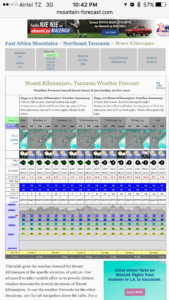
We would still climb in rain and snow, but the difficulty level would increase. About 6:30 am I woke up and got out of bed. I showered, and for what seemed like the 1000th time, I went over my Kit List and checked it against the items in my backpack and duffel bag. About 7:00 am, I left my room for breakfast. Russ and Chava were already eating.
I got my breakfast and sat down with them. The conversation was more subdued than the prior day. I think we were all nervous. About 7:30 am, I walked back to my room to get my bags. As I crossed the lodge entryway, a bus was pulling in. It was our guide service. I got my bags and went back to the front desk to check the luggage I would leave behind at the hotel. I also had them lock my laptop and passport in the main hotel safe. Russ and Chava walked up about that time with their gear. Our guide, Nick, spouted off a few instructions to the crew on the bus in Swahili. An army of men began to get off the bus. So, how many people would it take to get us three up and back down the mountain? Way more than I thought. For starters, we had a chief guide and an assistant guide. We had a chief cook and an assistant cook. Then to carry all of the gear and food for our adventure would require 14, yes 14 porters. In total, it would take 18 additional people to as Felix the Assistant Guide would say, “Assist in fulfillment of our intention.” Once all of our stuff was loaded on the bus, everyone, including us, got on the bus. Before we left, we shot this picture.
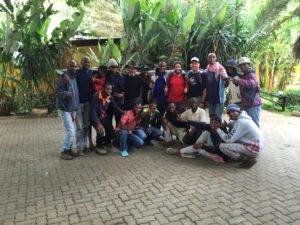
So, what were my first impressions? First, everyone seemed happy and in good spirits. For the most part, they appeared to be about 18-30 years of age. The guys on the bus were not much different than any other guys their age. They laughed, joked and teased each other. At least that’s what I think they were doing as I do not know Swahili. Next, I don’t want to sound rude, but I noticed the smell. To put it mildly, that bus was ripe! As I mentioned earlier, I had heard stories about other cultures not having the same hygiene as we do here in the U.S. I got used to the odor after about thirty minutes on the bus. Weaving in and out of traffic, we made our way out of town. About forty-five minutes into the bus ride, we stopped in a small village. Nick had told us the day before that on the way to the mountain, we would stop for the crew to eat breakfast. The bus pulled in to a very nice convenience store and gas station.

Nick told us that they would be going next door to eat and if we needed to use the restroom or wanted a drink, to go to the convenience store. I walked into the store more out of curiosity than need. I then walked next door to where the crew was having breakfast. It was a little outdoor eatery where all of the food was cooked in big pots over open burners. The main food that was being served appeared to be beans and rice.
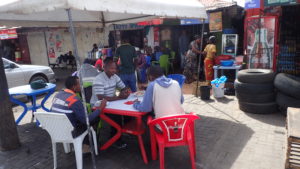
I hung out here for a few minutes, and then I walked out closer to the street. I just stood there and observed life in Africa. I think what stuck out the most was the lack of people following the rules, as well as the poverty. As I stood there, it occurred to me that in Africa, there are no safety nets to help the disadvantaged. Hell, from my perspective everyone I saw was disadvantaged. Life in Africa for these people is a constant and daily struggle just to survive. Although my heart broke for these people, my respect and admiration for the people and this country skyrocketed. Right then a thought went through my mind that perhaps one day I will live here. About ten minutes later, Nick called us all back to the bus. We loaded up for the remainder of our trip to begin our hike up Kilimanjaro. Here is a short video of the ride over.
Our next stop was at Londorosi Gate, at Kilimanjaro National Park.
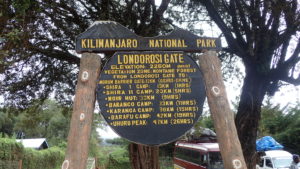
I was hoping to be able to see the mountain we were about to climb on the drive over. I couldn’t, because of the cloud cover. We had to stop at Londorosi Gate in order to obtain our park permits. This was also a point where park officials weighed all of the gear the crew would carry.
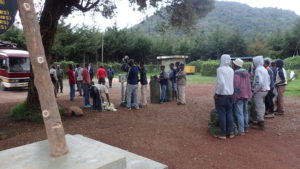
There are rules about how much weight each porter is allowed to carry. While we were waiting, it began to rain. Nothing too hard. Just a heavy drizzle. The altitude at this point was about 7000 feet.
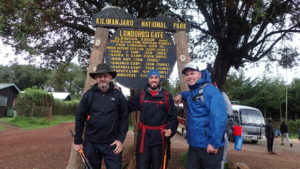
Although we were in a vegetation zone identified as Mountain Forest, the temperature was rather cool. There was a problem with the park’s computer system, so the stop here was a bit longer than normal. After about an hour, Nick called us all over to the bus and we loaded back up for the short trip to where our adventure would really begin; Lemosho Gate.

The elevation at Lemosho Gate is 2100 meters or a little under 6,000 feet. When we arrived at Lemosho Gate, the crew unloaded the bus. While they were getting everything ready to begin the hike, Joshua, the assistant cooked served us lunch. It was very tasty. The sign at Lemosho Gate said it was 48 kilometers to Uhuru Peak. This is about 30 miles. The route we would be taking would increase this distance by about 10 miles. When we set out, I was wearing a tee shirt and pants. Here is my official starting video.
It was very humid. A few minutes later it started to rain. It was at this point I realized that I had left my backpack cover at home. Luckily I had a backpacking poncho in my bag. Our goal that day was to make it to Mkubwa or Forest Camp. It was a 5-mile hike that at some points was very steep. Russ and Chava both had some issues with this hike, especially Russ, who was already battling some stomach problems. The path we hiked was well defined and easy to follow. Because we were in a rain forest, the ground was slippery. We saw a few monkeys in the trees as we walked, but outside of that, the hike was non-eventful and void of chatter. I think everyone just wanted to make it successfully through our first challenge. Here is a video I shot on the trail.
It took us about 4 hours to reach Mkubwa Camp.
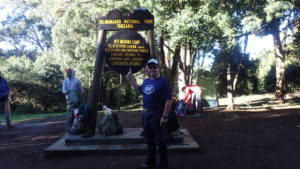
This video shows us entering the camp. When we got there, the porters had already got everything set up for us. Upon entering the camp, our guide Felix said something in Swahili to the porters. They replied back and he told each of us which tent was ours. The tents that our guide service uses are great.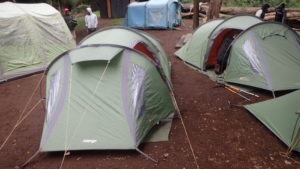
They are completely waterproof four-season tents. Although they are designed to sleep two, all three of us were on the trip as singles so we had the entire tent to our self. I settled into my accommodations by unpacking and arranging my bags. I always do this first thing when I arrive at camp while I still have light. The main thought you need to have when getting your tent arranged is easy access at night. The most important thing is to put your light source somewhere in your sleeping area so you can get it with little effort. At night, everything starts with a light. There are other little tips and tricks like instead of bringing a pillow, just bring a pillowcase and fill it with clothes. Here is another handy tip. In the middle of the night, you are probably going to have to get up and pee. Getting out of your sleeping bag, and then out of your tent in the middle of the night sucks. This is going to sound gross, but instead, I just bring a pee bottle. You not only never have to leave your tent, but with a little practice, you don't even have to leave your sleeping bag. Russ and Chava thought I was crazy when I told them this. Here is a tip. Get your sleeping bag and practice the pee bottle docking maneuver at home. It is not as easy as you think it would be and I think the "from the knees" method is easier than the "from your side" method.
About 10-minutes after I finished getting my tent arranged, the assistant cook, Joshua, tapped on my tent. He had brought me some warm water to wash with prior to dinner. I cleaned up and proceeded over to the mess tent. In the mess tent, there were 3 chairs and a table.
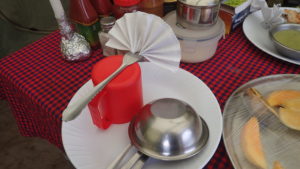
The table had a tablecloth and there were a bunch of condiments on the table. All meals started with a thermos of hot water to make either tea or coffee. Next, we would have hot soup. The soups they made tasted great and are my favorite part of the meals. They were simple broth soups. In the days ahead, the soups would become even more important as the temperature fell. Next, we would have some kind of main course that would include vegetables, a starch like rice or noodles, and then a small amount of meat. The dishes were tasty, but they would start to get old after a while because everything I ate in Africa seemed to have the same curry, ginger, nutmeg combination to it. On this night we had a beef stew.
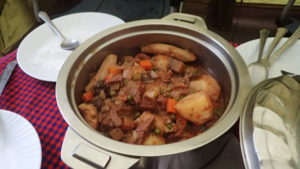
As I ate it, I thought about my kids and smiled. The words Beef Stew had a special meaning to my kids Jason, Walter, and Ellie. After dinner, there was not much talk. We were all tired and returned to our tents for rest. When I got back to my tent, I changed into my night clothes (wool socks, thermals, and a fleece shirt) and went to bed. That night, like most nights on the trip, I went to sleep listening to the porters talk and joke around with each other. Over the trip, I would develop both a happiness and sadness for the porters.

Africa is mostly extreme poverty. The porter’s life is not an easy one. They have to cover the same trail we cover, except they do it at an extremely fast pace with about 40 extra pounds balanced on their head or on their back. Their pay is $10 or less a day and they do it happily. My last thought that night before I went to sleep was a realization that the cash I had in my backpack was enough to completely change one of these porter’s trajectories in life. I was very thankful and I went to sleep.
About 3:00 am I was startled from sleep by grunting, growling and howling sounds all around my tent. I couldn’t tell if it was close or far away. I figured the safest thing I could do was stay in my tent. So I did. Once again, I was thankful. This time, for my pee bottle.
Chapter 10 Climb Day 2
I woke up about 6:00 am. The second my eyes opened I was a little confused and it took a second to remember where I was. I laid there in my sleeping bag for a while, just listening to the sounds going on outside my tent. There was a lot of activity, mainly by the porters and cooks. The monkeys in the trees were now making a weird clucking sound. A few minutes later, Joshua tapped the side of my tent. He had brought me some hot water to wash with. I thanked him in Swahili, “Asante.” He replied back in Swahili with, “Karibu.” I felt refreshed, but I was surprised to find out how cold it was outside. The temperature must have really dropped overnight. About five minutes later Joshua tapped on my tent again. This time I was already out of my sleeping bag and dressed and in the process of packing everything up for the day. Joshua asked me if I wanted coffee or tea. I told him I would get some later since I was busy packing. Joshua continued to stand there with his head poked inside my tent with a confused look on his face. After about three seconds he smiled and asked me again if I would like coffee or tea. Knowing that he was not going to take no for an answer I smiled and said, “Yes, I would like some coffee.” He made the coffee outside my tent and handed me the cup. Again, I said, “Asante” and again he replied with a sincere. “Karibu.”
It took me a few more minutes to get things packed, and then I was up and at ‘em. Russ was moving around in his tent and I didn’t hear much coming from Chava. About 10 minutes later, both Chava and Russ were up and moving toward the mess tent. That morning we had a standard breakfast of a scrambled egg, a sausage (hotdog), some hot oatmeal (which they called porridge) and then some toasted bread. To round things off, we had some bananas. We ate and got finished around 7:30 am. Nick, our guide, had told us that each day we would begin our hikes at 7:30 am. That wasn’t going to happen today because Chava and Russ still had some packing to do. It wasn’t a big deal, but I could tell that Nick and Felix were a bit irritated. Russ was packed lickity split. Chava, on the other hand, was on Millennial California time. This opened the door for Nick to start teasing around with him. You see, when Chava had booked his trip, he had used his given name and then wrote AKA Chava after it. Originally Nick had called Chava, Chava AKA. Nick did not understand the term AKA. So, for whatever reason, Nick started calling Chava AKA. Everyone, including the porters, was laughing and then one of the porters said something in Swahili to Nick. All of the porters roared with laughter. Nick then told us that the porters had been calling Chava, Jesus since we had been picked up back at the hotel. To their credit, Chava actually did look like what one would picture Jesus to look like. Then Felix and the other guides started singing some old school rap about California, and suddenly Chava AKA Jesus was now being called Hollywood because he was from California. A couple of minutes later it was decided that Chava would now be officially known on this summit attempts as Chava Hollywood AKA Jesus. That name would stick for the remainder of the trip. I shot this video as we were getting ready to leave camp.
It was about 8:00 am when we finally left camp. Nick had told us that Day 2 would be difficult. On this day we would pass through 3 vegetation zones and constantly gain and descend in elevation. The hike was tough and it was taking its toll on Russ.
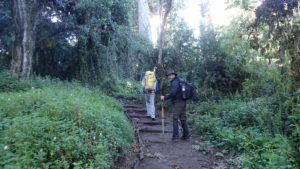
It seems like all we were doing on this day was going up and down, and then up again and then down again. Our goal today is to reach Shira Camp 1. The sign when we started said it was 7 kilometers away, but it felt longer. 7 kilometers is a little under 5 miles. One of the toughest parts of the day was climbing to the top of a ridge known as the Elephants Back. This ridge is in the vegetation zone was known as Heather Transition.

From the top of Elephants Back we still had about 2-hours left to hike for the day. It was at this point that I began to feel the effects of the altitude. About 20-minutes up the trail, something occurred to me. The trail we were walking on looked exactly like a trail I hike back at my home in Idaho around Dirkes Lake. It was really funny how similar everything was. The dirt, the rocks, the vegetation and even the moss-like stuff growing on the rocks looked exactly like home. As we went down the trail, I was right behind Felix. I matched Felix step for step as you can see in this video. Since the scenery was really not changing, all I did was concentrate on stepping where Felix stepped. After doing this for a while, I looked back and I couldn’t see the others. They had slowed down, and Nick, who was bringing up the rear, had picked up Russ and 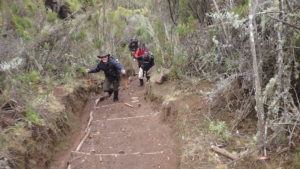
This meant that Felix and I could haul ass. Felix and I would talk every so often on the trail. This video is where I talk about how Felix described his job to me.
About 15 minutes outside of camp, 3 porters approached us. They had come back out to assist us in getting on into camp. Felix told me to give my pack to one of the porters. Knowing that they do not take no for an answer, I complied. We then waited a while for Russ and Chava to catch up. About 20 minutes later we all walked into Shira Camp 1 together.

The porters are absolutely amazing. I still can't believe how strong and fast they are.
The first thing we had to do upon entering Shira Camp was sign-in at the ranger station. Here is a video I shot as we entered the camp. After we signed in, I found my tent and started with the evening ritual of unpacking and getting ready for the night. Over the course of the day, we had ascended to around 13,000 feet, but then descended back to the back the elevation where we started the day which was a little over 11,000 feet. This was all by design to assist us in acclimatizing to the altitude. The goal each day was to climb high and sleep low. Earlier in the day, we had the option to stop and eat lunch. We passed and we were glad we did because about 20-minutes after we got to camp the rain started to fall. Less than an hour after walking into Shira Camp we were called to the mess tent for lunch.
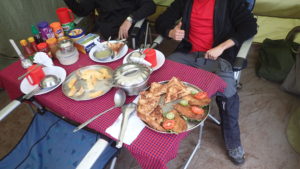
I was tired and really not hungry, but I knew that an important part of acclimatizing is continuing to eat and drink. For lunch, we had some fried fish and fruit. It was really good. As soon as I finished eating, I went back to my tent for a nap. Before I took my nap, I shot this video.
Along about 6:30 pm, Joshua tapped on my tent letting me know that he had set some hot water outside of my tent. He also let me know that dinner was ready. The soup that night was made from ginger and the main dish was vegetables, fried bananas and rice with little pieces of meat. There was even less talk at the dinner table that night as compared to the night before. As soon as I was done with my dinner, I went back to my tent and went to bed. I was asleep by about 8 pm and I had a very peaceful night of sleep. It did get very cold that night, but I was nice and warm in my sleeping bag. As I went to sleep that night I again thought about how positive and happy all of the porters were throughout the day. It was on day 2 that I noticed most of the porters were hiking in tennis shoes with no socks. Before I went to sleep, I shot this video.
Chapter 11 Climb Day 3
When I woke up on Day 3 it was cold. I am guessing it was in the 20’s. The skies were clear and it was on this morning that I got my first real unobstructed view of Mount Kilimanjaro. From my vantage point, it looked huge. Looking at the mountain I was intimidated. Once again, I had out-kicked my coverage. How would I ever climb that monster? I shot this quick video to start the day.
Breakfast today was quick.

We started hiking that day right at 7:30 am. Day 3 was advertised by Nick as being a moderately difficult day; slow elevation gain and not a lot of distance. The goal is to make it to Shira Camp 2.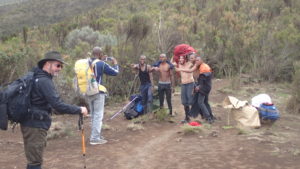
I think we hiked about 11 Kilometers that day. Here is a video a shot along the trail of some Cairns. About two miles up the trail we came across a camp called Scott Fisher Camp. If you have ever read the book “Into Thin Air” or seen the movie Everest, you probably already know who Scott Fischer is. For those of you who don’t, Scott Fischer was a world-recognized mountaineer and guide. In May of 1996, he several others lost their lives climbing Mount Everest. The trail we were walking on today was cut by Scott Fischer. About five minutes up the trail from Scott Fischer Camp is a plaque dedicated to him.
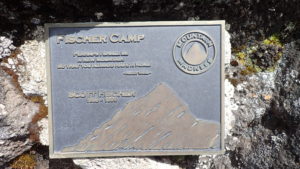
The inscription on the plaque read, “Perhaps I shall be a new mountain so that you will always have a home.” This is a verse from a poem written by Nancy Wood. Outside of this, the hike this day was really nothing out of the ordinary.
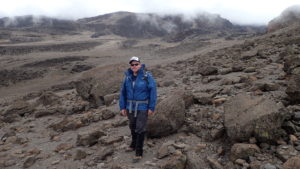
Again, I went into the mode where I stayed right behind our guide Felix and matched his movements step for step. Just like the day before, we quickly separated ourselves from Chava and Russ.
Felix and I arrived at Shira Camp 2 about thirty to forty-five minutes ahead of Chava and Russ. Here is a short video. I was not tired at all, so I explored the camp on my own. Chava made it into camp that day a little ahead of Russ. We ate some lunch and then Nick told us to rest a bit because around 4 pm we were going to have to take an acclimatization hike to a ridge that overlooked the valley. About 4 pm, I heard everyone rustling around. I got up and grabbed my pack. Felix collected all of us, and we began the hike up to a ridge that was about 600-feet above us. Once we got to the ridgeline, Felix told us we would need to hang out and chill for about 20-minutes. This was all part of the acclimatization process. It took us about 45-minutes to climb up to the ridgeline, but it only took us about 20-minutes to get back down. Once back down, dinner was waiting. You could tell that the toll of hiking was setting in because that night at dinner there was almost no talk at the table. Since we were eating kind of late, when I left the mess tent it was dark. It was cloudy that night so I was walking blind. I could make out the outline of my tent, so I just walked slowly and carefully. As I took the last step to enter my tent I stepped into the small tub of water Joshua always sets outside of the tent for washing. I think I said a couple of choice words, laughed and then went on into my tent.
With Day 3 now in the books, my last thought that night was that this had been a day well lived.
Chapter 12 Climb Day 4
I woke up right as the Sun was coming up on day four. I wanted to get some good pictures and video of the Sun rising on Kilimanjaro. I am not a professional photographer or videographer, but I do know that the best pictures and video take place at sun up and sundown. Therefore, I quickly got dressed and grabbed my Go-Pro and my digital camera. I set my Go-Pro up on a rocky ledge above the camp. I set it on time-lapse video. Here is the video. I then wandered around camp shooting various pictures with my digital camera. Like the previous mornings, we packed, ate and hit the trail quickly. The night before, Nick had told us that we would need to be ready to go as early as possible because we were going to put in a lot of miles on Day 4.

The weather this day can best be described as overcast and wet. The clouds were right on the ground. We were only about a mile up the trail before I was putting my rain gear on over my fleece. On this day, we would cover about 11-miles. Although the hike was long, I rather enjoyed it. It really felt like a test. Today we did some hand-over-hand climbing and several times the sky really opened-up with heavy rain and thunder in the distance. Somewhere about mile 7, Felix and I broke away from Russ and Nick. It was raining and cold and I just wanted to get finished. At about mile 9 we were served lunch. The porters had set up a tent and we had a terrific lunch. It took us about 30-minutes to eat. I shot this video at lunch. We then we set off for the remaining 2-miles to our next camp known as Third Cave.
Felix and I, along with Chava, reached Third Cave Camp about an hour before Russell.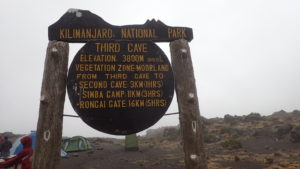
It was a nice flat camping area at about 13,000 feet. Flat is always nice when you are sleeping in a tent. I thought Day 4 was the toughest. When I hit camp I was tired. It is amazing how fast the porters can set up camp. The rain really took it out of me. Even though I was tired, I still felt strong. The rain persisted all through dinner and well into the night. That night I did not sleep well. I kept waking up. I think I was nervous because we were only a day out from our summit attempt. As I closed my eyes that night it popped into my mind that today was Thanksgiving back in the United States. I thought about my family and what they were doing and the fun they were having. I had a lump in my throat and I shed a few tears because I missed them. I wished that there was some way I could be both with them and here on this mountain at the same time. I also reflected on the regret I had for taking them for granted for so many years. You see, I was pretty much what would be best described as a workaholic absentee father. I thought about how thankful I was for everything in my life. I thought about my daughter Ellie and her battling cancer. Lastly, I thought about the sheer irony of me spending a holiday called Thanksgiving in one of the poorest countries ever known to humanity.
Chapter 13 Climb Day 5
On the morning of Day 5, I again got up and got dressed as the Sun was rising. This time-lapse video will give you a feel for how the day began. The clouds had cleared from the rain of the day prior, and the view really perked me up. As I looked out of the North end of camp I had a perfect view looking down into Kenya. When I turned slightly to my left, I had an awesome view of Kilimanjaro.
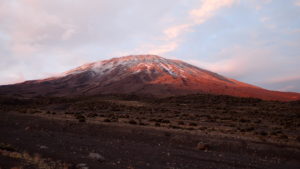
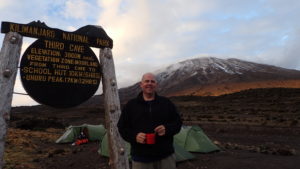
That day, our goal was to hike about 6 miles up to a camp known as School Hut.
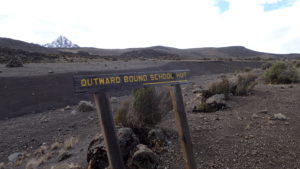
School Hut would be our Summit Base Camp. The hike would be short. Only about 4-hours. I think everyone was excited to make the move to Base Camp because there was a positive buzz in the entire camp. The porters set up breakfast outside and the oatmeal that morning was especially good. There was plenty of lively conversation at the breakfast table that morning.

The highlight was that Russ had been able to get a cell signal and send his girlfriend in Texas a text just before entering camp the day before. Chava had got some cell service the day before as well. Contact with the outside world really perked up both Russ and Chava. Somehow the conversation got around to me. One of the guys mentioned something about my family. I told them that I missed them, but I was sure they were having fun. I told them that a past foreign exchange student was visiting for the holidays.
We finished breakfast and I brushed my teeth. Before we set out on the trail, Nick called all of his guys together. For the next 5-minutes or so the camp was filled with singing and dancing. I videotaped everything, and I am glad I did. It was a really special moment. After the singing and dancing, we began the climb to School Hut.
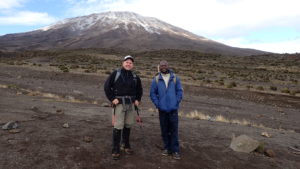
The trail started very flat but became steep quickly. About a mile up the trail we came across a dead Water Buffalo carcass. Nick said the carcass had been there for several years. He said the Water Buffalo come up to this spot at night from the lower regions in order to lick the salt that naturally forms on the rock walls in the area. The carcass had weeds growing out of its mouth and nose area. Because it was perfectly situated in a manner that looked very inviting to hop on its back and take a ride, both Chava and I seized the opportunity.

From the buffalo carcass, the trail again got steeper and it started to sleet. This video shows the weather conditions. The closer we got to our destination, more sleet began to fall. Again, I locked on to Felix’s 6 o’clock and he and I made it into camp ahead of the others. Pole pole. Russ was last to make it into camp. This video shows Russ coming in.
The elevation of School Hit is just under 16,000 feet.
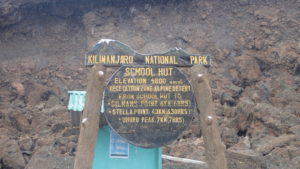
Earlier I had felt the altitude a little, but now I could really feel its effects on my lungs. The best way I can describe it is it feels like you have a heavy weight on your chest. The highest I had ever been prior to this is about 14,000 feet. Our campsite that night very uneven. My tent had about 2-feet of drop from one end to the other. This was expected. After all, we were literally on the side of the tallest freestanding mountain in the world. Once everyone was in camp, Nick told us that we would need to make an acclimatizing hike to a higher level before we could call it a day.
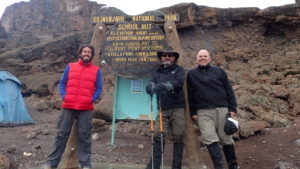
He asked us if we wanted to do it before or after lunch. We unanimously elected to do it immediately before eating lunch. With that, Felix got us all together and we headed further up the mountain.
Because this was only a short acclimatizing hike, I left my pack in camp. About 20-minutes after we left camp it started to snow big heavy wet flakes. My outer layer was fleece and Felix noticed this. Since he had his rain suit still on, he offered me his umbrella.
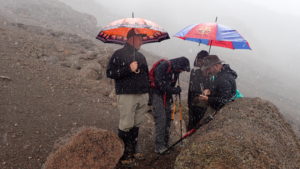
This was the first time in my life I had seen hikers carry umbrellas. Nick, Felix and several of the porters each had one strapped to the backpacks. The umbrella kept my fleece jacket dry and we reached the stopping point of our hike about 45-minutes after leaving camp. I shot this video while we waited. After the 20-minute acclimatizing wait period we descended back to Base Camp. When we got back lunch was ready. We ate quickly and went to our tents to rest.
I think I slept a little, but it seemed like it was no time at all before Joshua was tapping on my tent. When I woke up, I noticed a few differences in my body and the way I was feeling. For starters, my fingers and feet felt bigger as well as my eyeballs. I had a slight headache and my breathing seemed to be more labored. Since I had been at altitude before, I knew the swelling was the result of less pressure. I did not want a headache to get out of control, so I jumped right on it with Ibuprofen. In fact, throughout the entire trip, I had been taking one Ibuprofen at morning, noon and night. One other oddity was a weird tingling in my toes and fingers. Slowly, I made my way over to the mess tent. Nick was waiting there and so was dinner.
As we ate, Nick briefed us on how we would proceed that night with our summit attempt. He said that a decision had been made that Russ was going to get up at 10 pm, pack, eat some hot food and him along with Felix would depart camp for the summit at 11 pm. Chava and I would do the exact same thing only one hour later. He said if we did this, we should all reach the summit between 6 am and 7 am the next morning. Although the dinner they had prepared that night looked very good, I simply did not have an appetite. Maybe it was the altitude or maybe I was just sick and tired of the same old spices. Anyway, I passed on the most of dinner but did eat some soup because I was freezing. After I finished my soup I went back to the tent and tried to go to sleep. I shot this video from the comfort of my warm sleeping bag. It was cold and getting colder. The snow fell heavy for several hours.
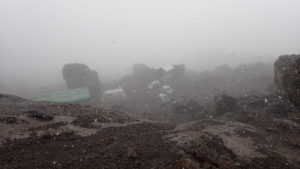
Every few hours we would have to shake the snow off of the tent to keep it from collapsing on us. For the next 6-hours, I think all did was doze off a few times. I don’t think I ever really slept. About 10:00 pm I heard them get Russ up. I laid in my tent for the next hour thinking about what I was about to do. Could I make it? What if something happened to me? Will my family be ok? What if I am the one that slows down the team and prevents us from making the summit? Thoughts like these would swirl around in my head for the next hour. Oh well, as I had heard said many times over the previous days, Hakuna Matata. No worries.
I finally decided to get up and get packed and moving about 10:30 pm. About 11:15 pm, I made my way over to the mess tent. There I ate some oatmeal and toast. I wasn’t hungry, but I knew I needed fuel. Nick gave us some last minute instruction and advice and the next thing I know what Felix called “The Midnight Event” was about to happen. We were heading for the summit of Mount Kilimanjaro.
Chapter 14 Heading to the Summit
It was right at midnight when we walked out of School Hut Camp. The head guide, Nick, was leading the way. Felix left with Russ about 11:00 pm. The trail was steep and rocky. For my birthday, the folks I worked with had given me a gift certificate to an outdoor store. I used the gift certificate to buy new trekking poles. The trekking poles were absolutely necessary to help me balance as I walked from rock to rock. I guess you could say that even in Africa I was being supported by my team back in Waco.
It was cold but not as cold as we thought it would be. The cloud cover from the snow had trapped some heat on the mountain. It was in the 20’s. Almost immediately I took off my outer coat. Even with the coat off, I still had 4 layers on top and 3 layers on the bottom. As I said, the climb was steep and took a lot of work. Pole pole. Slow and steady. About 45-minutes up the trail, I took off my gloves.
We had only been climbing for about 2-hours when we spotted Russ and Felix up the mountain. They looked really far ahead, but the gap between us closed quickly. Climbing in the middle of the night has its advantages. The main advantage is that everything is frozen solid. This means better footing on the rocks. The climb was tough, but both Chava and I were doing fine. At about 4:00 am, we caught up with Russ and Felix. Russ was having a very difficult time. Because we had made the decision to climb as a team, we all slowed down to Russ’ pace. Russ would take about three steps and then he would stop. Eventually, our slow pace led to several other climbing groups catching and passing us. We climbed through the night and as the sky cleared it got cold. It was so cold that the water in the tube of my hydration pack froze. I stuck it under my coat and blew into the tube to unclog the line of the ice. We were really going high. The thrill of the adventure gave me a huge boost of energy. Before I forget, here is a mountain climbing tip. When climbing steep grades, timing your steps with your breathing will make your go of it a lot easier. I am not sure why this works, but it does.
At about 5:45 am, we were still below Gilman’s Point. We were way behind schedule. Gilman’s Point is at 18,700 feet. I knew we should have already been through Gilman’s and approaching Stella Point which is the last major point below Uhuru Peak, the summit of Kilimanjaro. About then I noticed my shadow appear in front of me.
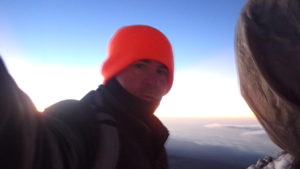
It was then that I turned and looked over my shoulder for the first time. What appeared before me nothing short of breathtaking. I was literally getting an 18,000-foot view of the Sun rising on Africa. It was magnificent. Here is a video. Several times I stopped to snap photos.

I kept thinking, how will I ever be able to describe this view to others. If I was not hooked on mountaineering, then now I was fully addicted. When you ascend a mountain, there is a saying that goes the higher you get, the higher you get. For the first time since my journey had begun, I had no doubt that I was going to reach the summit of Mount Kilimanjaro.
At about 630am, we reached Gilman’s Point.

The elevation at Gilman’s is 18,700 feet. Once you reach Gilman’s Point, you can technically say that you have climbed Kilimanjaro. The summit of Kilimanjaro is marked by three points; Gilman’s, Stella and Uhuru. Anyone who reaches any of these points is credited with summiting Kilimanjaro however both Stella and Gilman’s are both higher in elevation than Gilman’s. I was intent on reaching the highest point. The “Real” summit, Uhuru.
At Gilman’s, we took about a 10-minute break. I drank some water, had a piece of chocolate and ate a Digestive Cookie.
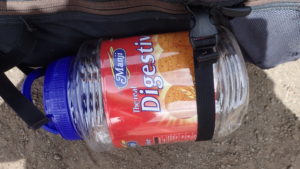
Please allow me to take a quick break from the summit story to tell you about Digestive Cookies. Beginning with our first lunch meal back in the rainforest at Lemosho Gate, something that was always offered when we ate and climbed was a Digestive Cookies. I call it a Digestive Cookie because that is the actual name of the cookie. I Googled “Digestive Cookie” and it said it is a product of the U.K. and was originally formulated to aid digestion. Although the name of the product is a bit of a turnoff, the cookie is actually quite good. It tastes just like a Girl Scout shortbread cookie. If I am able to find them here in the states, I will probably get some. Now back to the quest for the summit. After our break, we continued the climb to our next goal, Stella Point.
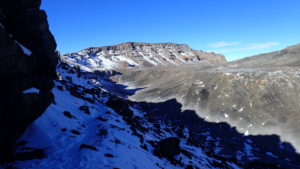
The climb over to Stella point was painfully slow. The altitude was killing Russ. I felt horrible for the guy, but I would not be honest if I didn’t admit that I was getting frustrated with the slow pace. Several times I looked back at Nick hoping for him to give us direction, but he didn’t. What should have been a 30-minute hike from Gilman’s to Stella turned into a 90-minute hike. We finally reached Stella Point.
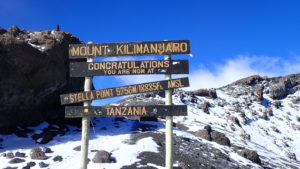
The altitude at Stella Point is 18,885-feet. Getting here was another major accomplishment. I don’t want to sound selfish, but I did not come 9,000 miles around the world to climb Kilimanjaro to Stella Point. I came here to climb all the way to Uhuru Point at 19,341 and regardless of the risks, that is what I intended to do. You could say that I had Summit Fever. Right before we reached Stella Point, Chava started looking at me to do something, kind of the same way I was looking for our guide Nick to do something. When we reached Stella Point, Nick called for a break. We all sat quietly for a minute and no one spoke. I finally decided it was time to address the elephant in the room. I said, “Guys, we need to have a discussion. It is already 2-hours past the time we were supposed to be at the top. Russ, we said we were going to climb as a team, and we will, but what do you want to do? Are you going to the top?” At that point, Russ looked up and announced that he did intend to go to the top, but maybe we should split up. I wasn’t so sure about this idea. I knew that at the pace Russ was going getting to the top would take hours. Anyone with any mountain experience will tell you that the later in the day it gets, the riskier it is to be high on a mountain. We weren’t just high. We were at freaking 18,500 feet! Nick, the main guide, said something in Swahili to one of the porters who was with us named Paul. He then said, “Chris and Chava, I want you to go with Paul and go on to the top. Me and Felix will stay here with Russ while he finishes deciding what he wants to do.” At that point, I figured that was Nick’s way of saying you guys go on so we can have a private discussion with Russ. Besides, once you reach Uhuru our route called for us to come back down to Stella to begin the descent. We would be up and back in no time at all and the climbing team would be back together. With that, Chava and I grabbed our packs and took off for the last 500-feet to the summit.
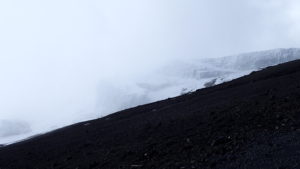
Before I leave this part of the story, I want to say that I truly felt sorry for Russ. I thought it was a real stand-up thing for Russ to be the one to suggest that we go ahead. I admire and respect him for doing that. One more thing. I again remind you that making it to the top of a mountain means you have just completed half of the work. Only a fool uses his last bit of energy to get to the top. As I write these words I hope that I always remember them and that they do not come back to haunt me.
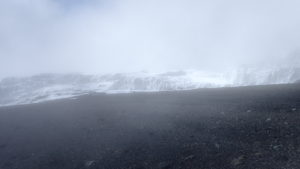
Only 500 more vertical feet of altitude stood between me and a dream I had been working on for years. The path from Stella to Uhuru is not overly steep, so I am quite certain that the altitude started to creep up on me because within 10-minutes of leaving Stella Point I really started to feel drained. So much so that I had to reach down into what I call My Bag of Tricks to keep my feet moving towards the summit. I shot this video on the way up.
Let me take a quick break to tell you about The Bag of Tricks. My bag of tricks is literally a plastic bag filled with items that symbolize and have special meaning to me. The most notable item in The Bag of Tricks is rarely in the bag at all. It is a purple bandana. Purple is the color for the type of cancer my daughter had; Lymphoma. That purple bandana has been with me on every major adventure I have ever done. When I look at this bandana, I see my daughter and the courage she had in withstanding almost 3-years of daily chemotherapy in order to beat the disease. One event that is burned into my mind and I can’t un-see is this one chemo procedure they had to do on her where they used 2 giant needles filled with a syrupy substance. The deliver the chemo they had to simultaneously shove both needles into the top of her thighs. Then slowly over about 5-minutes, they pushed the chemo into her little body. When I start thinking about whether or not I have what it takes to complete a challenge, that is the thought that comes to my mind. The next item in The Bag of Tricks is an email from my boss that passed away. He sent me the email on the morning of his fatal heart attack. Unfortunately, I did not receive and read the email until after he had already died. Although the contents of the email I choose to keep private, this item in The Bag of Tricks gives me confidence. The next item in my bag of tricks is a playing card. I will spare you the story, but from this item, I draw the thought of not being afraid to jump. Next, I have a gold necklace with a Marine dog tag on it. The necklace belonged to my father who was in the Army for over 40-years and was a decorated combat hero. The Marine dog tag is in honor of my son who is in the Marines. From this item, I draw a reminder to be brave. Next up is an item that is fairly new The Bag of Tricks. After I jumped out of an airplane on my 50th birthday, my coworkers gave me a little charm that has the word “Inspire” written on it. From this, I draw the idea of lead by example. There is one more item I keep in The Bag of Tricks, but it is personal. That item is my reminder to not give up easily. So that is all of the items in The Bag of Tricks. Now back to the story.
The last 500 feet to Uhuru Point took me about an hour. On several different occasions, I said to myself, “Just one more corner and I am there.”
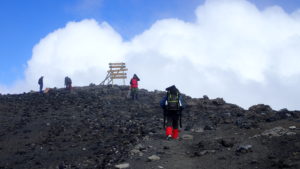
Finally, I reached a point where the sign marking the highest point on Kilimanjaro was fully visible. I could see it. It was about 100-yards away. In a couple of minutes, my goal would become a reality.
Chapter 15 The Summit
When I reached Uhuru Point, the highest and true summit of Mount Kilimanjaro, Chava was waiting for me. I shot this video as I took the last few steps. Chava reached the summit about 2-minutes before me. Also at the summit was our guide, Paul. The very first thing I did upon arrival was what everyone does. I walked up to the sign, put my hand on it and just stood there a while thinking about the journey I had to take to get to this point.
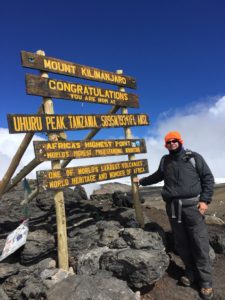
After a few minutes of that, I looked to my left and saw glaciers the size of buildings.
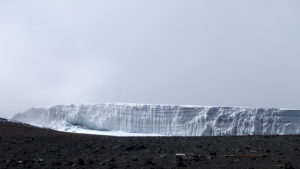
I have no idea how I missed seeing them walking up. It was probably because I was so focused on the summit. I then turned to my right and I could see the volcano crater floor below me, and then even more glaciers in the distance. I then glanced at my watch. The time was 9:32 am. Even though I was 3-hours late to the summit, I made it. When we got there, 3 other hikers were leaving the summit. I had heard stories about crowds being at the summit, but on this day there was only me, Chava and Paul. Once I got my wits about me and I had calmed down a bit, I then partnered up with Chava to shoot some pictures. I had 5 specific pictures I wanted to shoot. The first picture was just me standing by the sign. The next picture was me holding some banners I had made. The first banner had the logo of the brand I am working to develop; BMF Adventure Club.
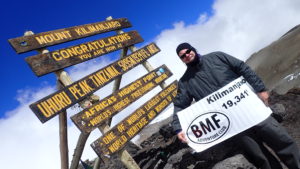
The next banner had the brand new logo of the company I work for, Nexstar Broadcasting. The last banner though was by far the most important. It said, “Dedicated to my Mom and Dad.”

Whenever I take on and complete a big adventure, I always dedicate it to someone special. Since this was by far my most grand adventure, the most fitting people to dedicate it to would be to the two people who gave me life and everything else it took to get me to this wonderful achievement, my mom, and dad. Unfortunately, my mom and dad died several years ago. If they were still alive, I know they would have been proud of me. The last picture I shot was of me holding a selfie stick. Last year my niece bought me a selfie stick Christmas. She was concerned that I would not know what it was for so she told her aunt to be sure to tell me that I was to shoot my picture with the selfie stick. That said, everywhere I have traveled to over the past year I have taken that selfie stick and shot a picture of me holding the selfie stick. I turned all of the pictures into a video and I gave it to her for Christmas last year. If You're curious, here is that video. Past that, to honor my parents, I brought two pictures of them with me to the summit.
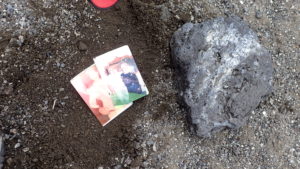
After I was done shooting my pictures, I walked to the backside of the summit and dug a small hole. I then placed the two pictures in the hole, covered it up, and placed a big rock on the top. It was kind of emotional. I then walked back over to the big rocks by the summit sign and sat down for reflection, a quick snack and a drink of water before heading back down. As I sat there, I couldn’t help but notice how quickly the clouds were building to the south. Light whispy clouds that were there a few minutes ago were now replaced by thick building thunderheads. Just about then, I saw a figure coming up the mountain. It was one of our porters. He had been sent up by Nick with instructions for us to wait for him at the summit. Since Nick is the person in charge, Chava and I complied. About 30-minutes later I made out three figures coming up the mountain. It was Felix, Nick, and Russ.
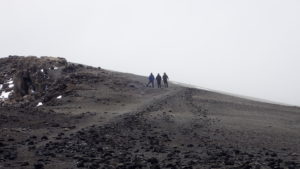
It took about 15-minutes for the three of them to reach our position.
Russ was still traveling slow, but he had made it. Here is a video of Russ reaching the summit.
Although I was genuinely concerned about the weather that appeared to be building, I was very happy for Russ. Russ had been at the top for a few minutes when I felt the need to confess. I told Russ that I owed him an apology. He said, “What for?” I said, “Because we left you back there. I really did not think you were going to make it past Stella and for that I am sorry.” He laughed and said something along the lines of he didn’t know if he could make it either, but he wasn’t going to give up. We had been working on a trail name for Russ since day one, that is when I said, “Russ, I think your trail name needs to be MVP because you are an MVP for overcoming and making it up here.” We messed around a while longer at the summit and it was obvious that the weather was building on our route down. So much so that Nick told us we should expect some adverse conditions on our descent. About 5-minutes later Nick said, “Ok guys we need to start heading down.” Here are a few other pictures from the summit of Kilimanjaro.
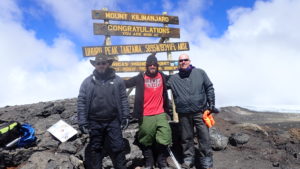
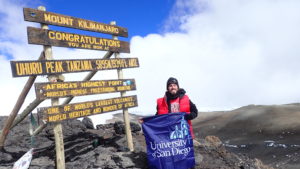

We started out with Paul in the lead with me and Chava following him. I shot this video as I left the summit. Everyone else was behind us. When we reached Stella Point I looked back and Russ, Felix, Nick and the other porter were nowhere to be seen. I shrugged it off and continued to follow Paul and Chava. About 10-minutes later the clouds really set in and it began to do something between sleeting and hailing. The air temperature dropped dramatically in just a few minutes as well. A few minutes later, the wind started to blow really hard. I saw it coming and shot this video right before it hit us.
When it hit, it was like we were in an almost instant hurricane. That is when I began to become concerned for my safety. After all, we were still above 18,000 feet on a mountain and at least one guy in our group, Russ, was in bad shape. I know enough about mountaineering to know that this is not good. Then out of nowhere, Nick appeared out of the fog. In nothing flat, he was right behind me. At this point, we were hauling ass down the mountain. Nick eventually caught up to me and said, “Chris, let me guide you.” I shook my head okay. He then said, “We need to go faster. Give me your pack.” Again I complied. He then said, “We need to go quicker. Just do what I do.” Although he was calm, I could tell something was not right. This freaked me out a little. Within minutes the intensity of the storm had increased. The sleet was heavier and the wind was stronger. About 20 minutes later, Nick and I caught up with Chava and Paul and passed them. We were at about 17,000 feet when Nick called Paul up to the front and we stopped. I was hearing a lot of thunder coming from below us. Where there is thunder there is lightening. the last place you want to be in lightning is 17,000 foot up a mountain. Nick and Paul's discussion that lasted about 3-minutes. It was all in Swahili. Nick then turned to me and said, “We are going to take a shortcut.” With that we left the trail we were on and made a 300-yard traverse, or parallel crossing of the mountain through some very loose scree rock. Once on the loose scree, we began to quickly descend down the mountain by doing what can only be described as skiing on the scree gravel. To do this, you lean way back and take big steps and keep your toes pointed up at the sky. I had used this technique before, so it was no big deal. Nick and I were outpacing Chava and Paul. Eventually, we lost sight of them up the mountain. We continued to “ski” down the mountain for about 45-minutes and eventually we were out of the weather. At some point, we made a move back to the right on the mountain. That put us back on a trail. We followed this rocky trail for about an hour. The trail had many switchbacks. Eventually, I could see a camp in the distance. Nick turned to me and he said, “That is where we are going.” I turned around and looked over my shoulder. Nick and Paul were nowhere to be seen. About 20-minutes later we were at Barafu Camp.
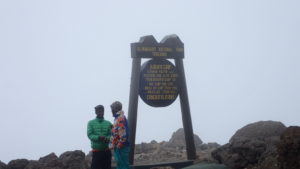
All of the times I mentioned above are just guesstimates.
Barafu Camp is at about 15,000 feet. The usual trip from Stella to Barafu is about 4 hours. We had made it in about 2. We sat down on a bench at Barafu, in a place where Nick could see the trail leading into camp. We waited there for about 30 minutes. The original plan was that we would have lunch in Barafu, and then descend through High Camp, Millennium Camp and finally stop for the night at Mweka Camp. From Stella Camp to Mweka Camp is 12-kilometers or about 7 ½ miles. Because we were so late getting to the summit, and because Russ was having issues, Nick had already sent word down the mountain for the porters to go ahead and move from Barafu to Millennium Camp. That said when we got to Barafu, the last of the porters were leaving, heading down the mountain to Millennium. As I said, we had waited for about 30-minutes when Nick called to one of the porters, God Bless, who had not yet left Barafu for the lower camp. Nick told God Bless to take me down, and then to send some people back up to help with Russ. He also wanted them to send up food because it had been well over 12-hours since Russ and Chava had eaten. He knew that when they finally got them to Barafu they would need to be fed before continuing the journey to the lower camp. God Bless looked at me and said, “Give me your pack so we can go fast.” God Bless and I then began our descent.
Because I knew it was very important for us to travel quickly, I told God Bless that I was still strong and I was willing to go as fast as he wanted. God Bless then kicked it up to “Porters Pace” and we sped down the mountain together. This is a video I shot to show you how fast these porters travel. I had to jog to keep up. All along the trail to the next camp, we passed these one wheel rescue carts.
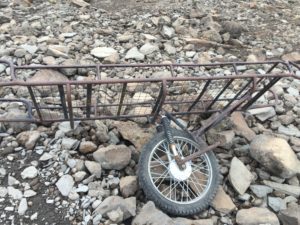
We finally made it to Millennium Camp at some point between 2:30 pm and 3:00 pm. The altitude of Millennium Camp was 13,000 feet. In 4-hours I had descended over 6,000 feet and that included the 30-minute hold at Barafu camp. I was beat. There was a steady drizzle coming down at this time. Because I had made it to camp so quickly, the only tent that was set up was the mess tent. I walked into the tent, dropped my stuff and collapsed into a chair. I had now been traveling for over 14 hours and had not eaten for over 15 hours. I went through my pack and found some chocolate. I ate it and it was good. A few minutes later one of the porters came into the mess tent with some hot water for tea. I made some and drank it. I was freezing cold and it warmed me up. Then a few more minutes later another porter came in with a sleeping bag pad. He laid it on the floor and I laid down to take a quick nap. Before I went to sleep, I made a short video about what had just taken place. I went to sleep and woke up about 30-minutes later. I looked out the door of the mess tent and saw that they had put up my tent. I was ready for some real rest so I grabbed my stuff and headed over. That night there would be no arranging of the tent.
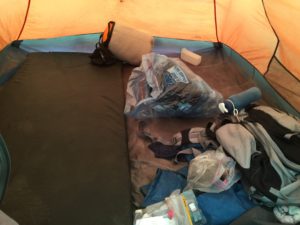
I was so tired that I literally tossed my bags in the tent, took off my clothes and got in my sleeping bag. I fell asleep so fast, I don’t even remember falling asleep. About 9:30 pm I woke up. It was completely dark. Because I had not taken the time to situate my gear, it took me about 5-minutes to locate a headlamp so I could see. I knew that I had missed dinner, but that was okay because even though I had not eaten in almost 24-hours, I was not hungry. I rolled over and went back to sleep.
Chapter 16 Climb Day 7
I woke up the next morning about 6:00 am.
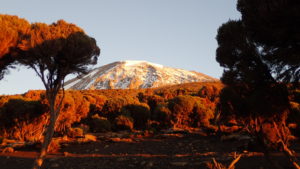
My first thought was about Chava and Russell. I could hear Russell snoring in the tent next to mine, so I was confident both had made it to camp safely. I am not sure why, but I was having some balance issues. On top of that, I was really short of breath. I walked around the camp for a while, shooting pictures, and after about an hour the problems passed.
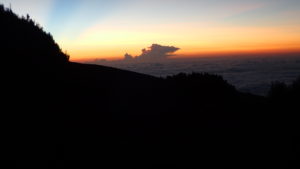
Eventually, Chava and Russell got up. Both of them looked like hell, especially Russell. Chava told me that he had finally made it to camp around 5 pm and that Russell had come in at some point after 7 pm. Russell said later that he was delirious and hallucinating on the descent. I believed him. None the less, I was still proud of both of them because they had made it to Uruhu and back down.
We had our normal standard breakfast. It was good, but I was ready to be done. At breakfast myself, Chava and Russ discussed the tip we were going to give the crew. When we presented the tip to the crew, I could tell they were a bit surprised with our generosity. The tip money I gave came from my work of delivering Dominos pizza in the 3-months prior to my trip. That’s a story I will share some other time. It's a whole story in and of itself. After the tipping ceremony, Russell mentioned he had a big blister. I had brought some moleskin, so I gave it to Nick to help Russ with his blisters. About 715am, we started out for our last hike of the trip. Here is the video I made as we were leaving. From Millennium Camp we would descend about 2-miles to Mweka Camp. From there, we would descend another 6-miles to Mweka Gate which would complete our Kilimanjaro adventure. Even though we had taken a beating the day before, we moved down to Mweka camp in short order.
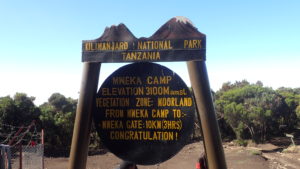
We stopped along the way and shot a picture or two and I continue to be amazed at how strong and fast the porters move.
When we got there, Nick told Felix to go to the ranger station and order up a car for Russell and Chava. Russ was dealing with blisters and Chava was having some knee pain. By ordering up a car, this would cut about 2 miles off of the remainder of the trip down that mountain. As for me, Nick looked at me and smiled. He said, “Chris, you are going to follow me.” He then gave me a huge smile. With that, we took off fast out of Mweka Camp. As you will see in this video, Nick was trying to give me a real test. From Mweka Camp to Mweka Gate, 6-miles, I had to maintain a steady jog to keep up with Nick. At first, it was no big deal. The air was cool, and man was we moving. However, once we hit the rainforest zone, things got steamy real quick. We only stopped once because I asked a question about this odd tree. It was a Camphor tree.
The stop was only for about 1 to 2 minutes and then we started moving again. We were moving so fast we were passing porters. I thought we were close to the end when Nick announced that we were only halfway to the gate. I was determined not to ask him to slow down, so I sucked it up and continued. Eventually, we broke out of the jungle and hit a road. Here the footing was good. We continued to blaze a trail for the gate.
Eventually, we came around a corner, and I saw it. Here is a link to a video I shot as we were finishing up the trail.
The sign said Mweka Gate, Congratulations. I had completed my journey or as Felix would say, fulfilled my intentions. When we reached the sign by the gate, we first stopped for Nick to sign us in at the ranger station. Here is a video of the check-in process.
After that, Nick shot my picture beside the sign.
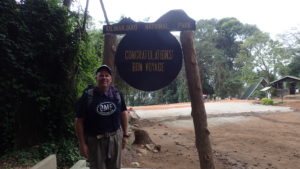
From there we made our way over to the other ranger station. This is where I would I would sign the official registry and receive my official certificate of completion for climbing Mount Kilimanjaro. There was a small area next to the ranger hut where hikers could sit down and rest. I asked Nick if there was a place to buy a soft drink and he said yes, right outside of the gate. I picked up my backpack and walked over to the gate. Immediately, I was surrounded by vendors trying to sell me stuff. I told them that all I wanted was a Coke and eventually a guy popped out of the crowd with a coke. I asked him how much and he said $3. I knew I could bargain him down to $1, but I was too tired to negotiate. When I got my Coke, I went back into the park because the vendors were not allowed inside the gates. I waited about an hour and a half for Nick and Russ to make it down in the car. When they showed up, Russell had to sign some special book at the ranger station since he had officially been “rescued” the day before. Both Russell and Chava then went to the main ranger hut and signed-in as completing the mountain climb.
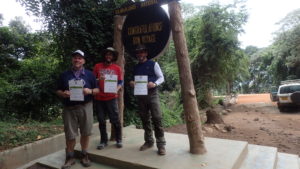
We all went back over to the Mweka Gate sign and shot more pictures and then we headed out the gate to board the bus back to town.
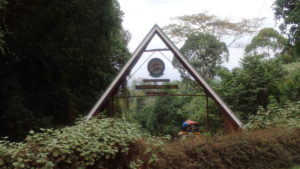
From Mweka Gate it was about an hour drive back to the city of Moshi. We went through a lot of mountain villages on our way to town. Here are a few shots from the drive out. We stopped in Moshi to eat lunch. All of the Americans had a hamburger and fries, while Nick and Felix had a stew made from cows tongue.
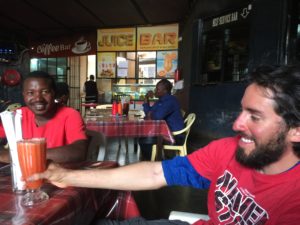
The name of the restaurant was Chrisburger. I laughed at the name. They had an interesting menu hanging on the wall. It included beer, liquor, cigarette, condoms, and Panadol.
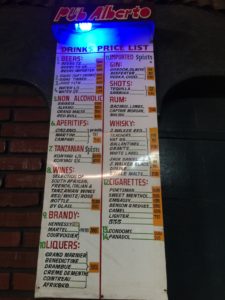
Pretty much everything you need for a hot African night. At lunch, Nick presented us with our Kilimanjaro completion certificates. When we were done eating, we loaded back up on the bus and drove another hour back to the town of Arusha. Russ and Chava slept on the way back. I sat quietly listening to the porters talk and reflecting on the journey.
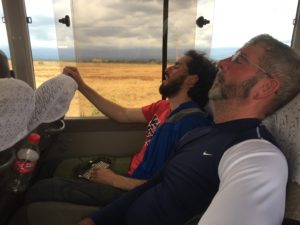
When we pulled back into the gates of our lodge, all of the porters got off of the bus to help unload our gear. We all said our goodbyes, shot one last picture and with that our adventure came to an end.
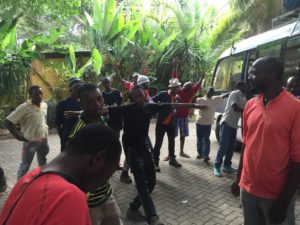
Russ and Chava left the next day. I was not scheduled to leave until the following day. I shot this video as I was getting on the plane to leave Africa. Kilimanjaro.
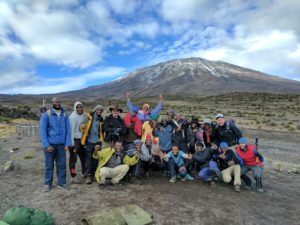
I still remain in contact with Chava, but I have never talked to Russ since that last day we were together in Africa. In June of 2017, Chava flew to Austin and participated with Ellie and me in a Make A Wish fundraiser. Together the three of us raised $7,000. This fundraiser was unique in that it had a challenge tied to it. The challenge was to complete a 500-foot rope rappel from a high-rise hotel in downtown Austin. All three of us did it. I was terrified. Ellie and Chava loved it.
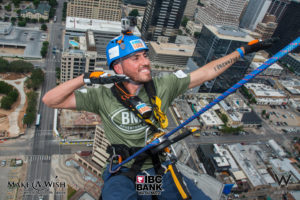
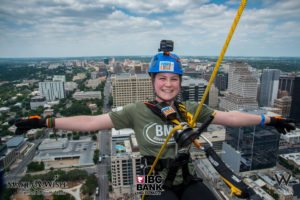
On my last day in Africa, I went on a safari. I will include information on that at the very end of the book. Truth be told, the safari was as exciting, if not more exciting, than the mountain climb.
About the author, Chris Pruitt, and his family. Also some personal thoughts I would like to share.
When you climb mountains, you have a lot of time to think. I did a lot of thinking while I climbed Kili. Here I will share a few of those thoughts, tell you more about me as well as my family.
Awhile back in this book I mentioned materialism. Materialism was a huge issue for me. Africa is a great place to examine one's materialistic tendencies. Yes, maybe we do live in a material world, but a few years back I was consumed with it. I think my problem stemmed from me wanting to prove to the world that I was somebody.
Growing up, I am not completely sure what social “class” I was in. My mom and dad worked hard and gave us kids everything we ever wanted. We lived in a small house with 3 bedrooms and 1 bath. It was fine and we made due. My folks drove old cars. In 1976 we got our first “newer” used car. I remember when I was very young my mom at one point making weekly trips to a store downtown where she would run in and come right back out. It was a pawn shop. I didn’t know that then. As for me, I was always the self-depreciating class clown. That’s what you did when you were overweight and not very good in school. I made fun of myself so the other kids wouldn’t. It hurt less when I was the one making jokes about how fat I was. My grades were always barely passing. I was not what you would call popular in school. I had a small group of close friends. In high school, I went half a day to regular school and half a day to “Technical” school. This is what kids like me who were identified as “non-college bound students” did back then. We went to tech school. I graduated from high school, barely. After a few years working, and with some encouragement from my then girlfriend, Rebecca, I did attend and later graduate from college. I would never have gone to college had it not been for her. If she ever reads this, thank you, Rebecca. I still owe you. In college, my grades were good enough to pass and get the degree. I am not sure at what point I caught the bug and became so driven to be “rich”, but something happened and I became consumed with materialism. I think I had a chip on my shoulder. I wanted to prove something to all of those people who had looked down on me or made fun of me in the past. I always told myself that my never-ending push for more money was something that I did for my family. It wasn’t. I did it for me.
So here’s the truth that I discovered one day. The life that I was killing myself to create was nothing more than a construct; a façade. Something that I had consciously built for one reason and that was to impress others. It was almost like a checklist; beautiful wife-check, high-profile job-check, big salary-check, model children-check, fancy house-check, fancy cars-check…. To anyone on the outside, I had what appeared to be a perfect life. It was not perfect. As I said, it was all just a construct. Sure, I had worked my ass off to acquire everything, but to what end? I did it for the wrong reason and I didn’t really appreciate any of it. It really just created more problems. I could never just be myself. I could never drop out of character. Since I am being honest, I was an absentee husband and also a terrible absentee father. I spent a ton of money buying things so that I could impress people I didn’t even like. At some point, I was so consumed by acquisition that I even lost my desire to be friends with others. Everything in my life was strictly business.
My last word on materialism is words I am sure you have heard before: Either you own your stuff or it owns you. Bills and payments limit your choices and will make your life miserable. I have zero interest in keeping up with the Jones’ anymore. Although most of my existence has been spent working hard to create a life that looked like everyone else’s, my goal now is to just be me. Being the real "Me" makes for a life that looks very different than what others call normal. If people find the way that I now live my life odd, I really and truly do not care. Yes, I am an old, fat, bald guy who wears funny tee shirts and does crazy stuff, but so what. That’s me and that’s what I enjoy. It beats the hell out of following the herd. Besides all of that, my kids, especially my daughter, think I am cool. That’s the only validation I care about.
Speaking of the kids, my oldest son, Jason is 22. He is a machine gunner in the Marines and is stationed in Hawaii. He’s a real Jarhead. When it comes to shooting his belt-fed weapon, he says accuracy is attained by volume. My middle son, Walter, is about to turn 20. He works full-time as a caregiver for people with special needs. He also has a Black Metal band called Inhuman Wrath. If you’re not familiar with Black Metal, the music is very fast and the lead vocalist sounds a lot like Cookie Monster from Sesame Street. Walter has played guitar since he was 6 and has tremendous talent. He also plays drums and keyboards. Since Walter is not a very Black Metal sounding name, on stage he goes by Lord Shredder. I have shared a lot so far about my daughter, Ellie, but here is a bit more. She is 17. She is smart, beautiful, driven, incredibly courageous and as you read, a cancer survivor. She loves to play cello and also excels at persuasive speech. In 2015, she was the keynote speaker at dinner for a celebrity golf tournament in Sun Valley, Idaho. It is an annual tournament that raises money for cancer research. The night she shared her story a new record was set and they raised over $1-million. On balance, I would say I have a very unique and eclectic family.
If you go to my website www.BMFAdventureClub.com you can keep up with all of my adventures. Also, I write short articles and post them there on various topics I find interesting. On my website, you can also find links to my Facebook page as well as my Linked In page where I post things "professional" in nature. At present, I am working on another tall mountain adventure. I plan on climbing Aconcagua in Argentina. It is the 2nd tallest of the 7 Summits. I had planned to climb it in December of 2017, but I decided a week ago to put the attempt on hold for a year. The timing was not right and I have been sick as of late. Climbing Aconcagua will be a good test before my "Adventure of a Lifetime" that I plan on taking in the Spring of 2019. I do not know if I will make it to the top Aconcagua, but as with all things I will do my best and enjoy the view.
I still continue to work in the media business in Waco, Texas. In August of 2017, my daughter moved from our home in Idaho to be with me in Texas. Her mother decided it was time to return to Texas and we wanted Ellie to start her junior year of high school in Texas.
I don’t think I shared this, but since moving to Texas over two years ago I live in my RV out in the country. I love it. It helps me maintain a feeling of freedom. I also could not take the thought of living in a "rat cage" some call an apartment. It's too confining. I also have "germ issues." I am willing to bet that I am the only guy in my line of work who lives in an RV "down by the river." I enjoy my minimalist lifestyle. I also enjoy meeting new people. I think people are most genuine towards me when they meet me as Chris the guy that lives in the RV down by the river versus Chris the media vice president that runs TV stations. People change when they find out about my real background, and line of work.
When Ellie moved down from Idaho to live with me, there was a small adjustment period for her as my home in Idaho has 6 rooms, 3 baths and is a little under 4,000 square feet. My RV is about 400 square feet with one bedroom, a tiny shower and about 6-minutes of hot water. As of this writing, the home in Idaho is still for sale if you are in the market. We recently purchased a house for her mother here in Waco. We've been seperated for several years. Ellie has left the RV and now lives with her mother. I know she is very happy to have her mom and dad back living in the same city. Again, I am quite proud of the adjustment my daughter made while living with me in the RV. It will be a story we will share, and that I hope impacts her, forever. The other day her mother told me that Ellie had told her that she now realizes that she was most likely a spoiled, rich, white girl. She is smart, so perhaps this was the beginning of her recognizing that money is not what makes you rich. As for my two sons, I am extremely proud of both of them. I used to try and push my kids in the direction I thought they should live their life. Now, I just encourage them to follow their passion and be themselves.
I plan to continue chasing adventure. There remains a lot of things left to do on The List. If you want to check out my progress on The List, you can do so at www.BMFAdventureClub.com/The List. I now do some public speaking from time to time. I really love to tell stories. If you ever need a speaker for an event or meeting let me know. You can find a list of my favorite topics on my website.
In closing, Helen Keller said, “Life is either a daring adventure or nothing at all.” If in the end my kids are proud of me and I have set a good example and inspired them to step outside of their comfort zone and live a grand life, then I will consider my time on earth well spent.
Don't be afraid to get lost. If you're not lost, then you're really not exploring. Our life is brief. Never forget that. All things in life, including life, are temporary. Whether you are happy or sad, be patient. Change is heading your way.
Now Go Find Your Adventure and Live Your Life.
PS - Why the title, It's All Downhill From Here? When I was coming down Kilimanjaro, I used this saying twice; once as I talked to Chava right as we were being hit by the storm below Stella Point, and then again as the team was leaving our last camp heading to the gate. Same words. Different meaning. Like life, it is all about perspective.
HERE IS THE PART FOR THOSE WHO PLAN ON CLIMBING KILIMANJARO
If you are a person who is seriously looking at climbing Mount Kilimanjaro, here is some random information that you will find handy.
As far as the guide services go, there are many. I used Team Kilimanjaro (you can Google them). I thought they did an outstanding job. You could go with guides located here in the states, but the reality is they probably just end up using one of the guide services in Africa anyway, so shop around.
So, what all comes with the fee you pay a guide service? Although it can and will vary a little, basically you the money you pay will cover hotel cost before and after the climb in either Moshi or Arusha. It will also cover transfers to and from the airport. Lastly, it will cover everything you need while on the mountain. If you decide you would like so some extra hotel nights before or after your climb, your guide can arrange this for you. When I was in Africa, the only thing I spent money on was food before and after the trip, tips for the guide team, gifts, a SIM card for my cell phone and taxi service.
As I mentioned earlier, when you climb Kili you will stay in either Moshi or Arusha. I stayed in Arusha. It was a fantastic place.
Getting around Arusha is easy. Cab fare is cheap. You can actually walk most places, but be sure to grab a local escort at your hotel. Don’t walk alone. It is probably safe, but why chance it. For $20 they will walk around with you for 3 or 4 hours.
While in Arusha I mostly ate at my hotel. If you want to go out on the town and get something different your hotel will give you guidance on safe places to eat. Meals are inexpensive. Speaking of safe, just like Mexico, don’t drink the water. There are plenty of places to get bottled water. On the next to last day of my trip my guide, Nick took me on a real tour of Arusha. While we were out we went to a little market and had some food. The meat we ate was hanging in a window with flies right before they cooked it for us. I’m a medium rare guy, but in Africa well-done, please! The meat was tasty, and we dipped it in salt as we ate it. A cat was hanging out close by our table, so I fed a lot of my meal to him.
At the hotel where I stayed, they had pretty good Internet service. It was fast enough to Skype. In the story, I mentioned that I bought a SIM card for my cell phone. Cell service is really good in Africa. I even got service a few times on the mountain. If you intend on using your phone in Africa, you will need to have your cell phone unlocked by your cell provider in the United States. As for real cell phone service on the mountain, it is a real hit and miss. Do not expect to have service on the mountain unless you have a sat phone. If you are interested in a sat phone you can rent them online. Personally, I think it is a waste of money. You’re on the mountain to escape.
When you go to Africa you will need a power converter. The type of power converter that you will need is the same you would buy if you were going to Europe. One other note, the power in Arusha is not completely dependable. It comes and goes. I watched a little TV while I was there. Lots of varying programs in many different languages.
As I mentioned in my story, I flew on Delta KLM. I believe several airlines fly into Kilimanjaro. Check The Google for specifics. As I said, you do not want to lose your baggage so limit your connections and most importantly WEAR YOUR HIKING BOOTS.
Let’s discuss altitude. As you probably know, there is exactly the same amount of oxygen at 20,000 feet as there is if you were standing on the shore of an ocean. The issue has to do with the density of the air molecules. Think of it like this, when you inhale a gulp of air in Dallas, Texas, that gulp contains more molecules of oxygen as compared to a gulp of air inhaled in Denver, Colorado. Because each gulp of air contains less oxygen, your body starts saying WTF. This is what’s called altitude sickness. Altitude sickness comes in many sizes. If you climb Kili you will experience at least mild altitude sickness. Altitude sickness can kill you, but do not freak out about it. Your guides number one goal is safety. Also, they know that if you die or can’t walk they are going to have to drag your ass off of the mountain. Knock on wood, the altitude has given me little problem over the years. The best way to stay ahead of altitude sickness is to take Tylenol a few times a day and stay hydrated. How much water should you drink? Well, just drink more than normal. You do not have to drown yourself but drink often. I will cover the water containers you need to bring in the gear list at the end.
Diamox. Okay, if you start surfing the web asking questions about high altitude hiking and climbing, you are going to come across people talking about a drug called Diamox. I am not going to spend much time talking about Diamox because there is so much on the web about it. Diamox is a drug you can take that will help you combat altitude sickness. As I understand it, it makes you breath faster which then causes you to take in more oxygen. It will also cause you to piss more times in a day than Kellogg’s has corn flakes. I got some for my trip. My doctor prescribed it to me. All I did was ask. He said I should take a few beforehand just to make sure I did not have any adverse reaction to the drug. I did. I took a leak 21 times between 7 am in the morning and 11 pm at night. Although I took the drug with me on the trip, on the way over I started thinking about it and decided I was not going to use it. My thought was this, if the only way I can make it to the top of this mountain is with a drug then I probably do not deserve to be there. Oh yeah, one more thing. I was told you take Diamox prophylactically. I assume this means you put the pills in a condom and swallow it kind of like the way heroine smugglers do. Since I have a sensitive gag reflex, I think I better pass. To my sisters who are both nurses, no I am really not that stupid. I'm just kidding. In closing when it comes to Diamox, just listen to your guides. If they tell you to take Diamox then take it. If not, I would recommend not taking it. I believe both of my climbing partners took Diamox.
The official currency in Tanzania is the Shilling. The exchange rate is about 2,000 Shillings to 1 USD. I read something that said you need to make sure that your USD were issued after 2006 due to counterfeit concerns. You also need to take a load of dollars bills. There are plenty of places to exchange currency in town. Just ask someone at the hotel. Credit cards are accepted, but I would recommend just taking cash. Concerning your credit cards, you need to call your bank and let them know you are going to Africa. There is a ton of fraud that comes out of Africa, and if you don’t clear usage ahead of time your charge will most likely get declined. I took $1,500 in cash. My biggest cash expenditure was the tip for the guides and porters. As relates to tipping your guides, there is all kind of overly complicated methods to figure how much to tip your guides and porters. You can Google it or below I recommend a book. Either way, there is plenty of info out there on how to tip your guide team. Be generous. The tip is usually a little ceremony that takes place on the night before the last day of the trip or the morning of the last day. Generally, the tip for the entire team is given to the main guide and he divides it up among the team. There will be individual porters that will make your life on the mountain easier. I recommend personally tipping these people just to make sure they actually get the money.
Travel Insurance. I recommend you buy foreign travel insurance. I purchased my insurance from World Nomads. The cost was about $400. The reason you need this insurance is to cover costs if you need to be rescued or get sick and need medical treatment. The way to go about buying this insurance is just going to the web, look up the number and call them. When you call they will ask you questions about your trip. Kilimanjaro is right at 6,000-meters so you will need to get coverage that covers you up to that altitude. They will totally walk you through the process and explain all of the coverages and options.
The official language in Tanzania is Swahili. I picked up on a few words like please and thank you. The Swahili word that you will hear over and over is Pole. This means slowly. Slow and steady wins the race up the mountain.
There are 5 routes up Kili. The route I took is called the TK Lemosho. The TK stands for Team Kilimanjaro that created the route. The route is a 7-day trip. I chose this route based on research I did on the web. What I liked most about this route was it gave me plenty of time to acclimate. I will not write on the other 4 routes since I have no personal experience on those routes. Just Google Kilimanjaro Routes and you will be overloaded with tons of information on each route.
The best months to climb Kilimanjaro are January through March and June through October. The reason these months are the best is due to rain. Climbing Kili in the rain kind of sucks. I know. It rained or snowed 5 out of the 7 days I was on the mountain. I climbed in November over Thanksgiving.
Here is a book that I would recommend you buy and take on the trip with you. It is titled Kilimanjaro, The Trekking Guide to Africa’s Highest Mountain by Henry Steadman. This book was awesome and will fill in all of the blanks I neglected to include.
Here is the gear list I made for my trip to Kilimanjaro. As usual, I took way more than I needed. Next, to each item, I will note whether I used the item or just took it on a trip to Africa. As for luggage, I packed all of this into an oversized suitcase, a backpack (50-Liter) and a Leader brand waterproof duffle bag (90-liter). You do not need to invest a ton of money into either a backpack or duffle bag unless you will use it in the future. In fact, all you really need for the trek up the and down the mountain is a small daypack. I would though encourage you to get a duffle bag with plenty of room like the 90-liter one that I used. Make sure it is waterproof. You do not want to sleep in a wet sleeping bag.
Packing List
- Kilimanjaro Book
- Copies of Important booking and Insurance documents
- Passport
- Shot Certificate
- Cash with lots of 1’s
- All of my good luck charms - (This is my bag of tricks I talked about earlier)
- Selfie Stick - (I was making a video for my niece. It’s another story.)
- Chargers for all of my stuff
- Extra Auxiliary chargers
- Electrical outlet adapters
Medical and Toiletries
- Diamox - (I never used it and gave the prescription to my guide)
- First Aid Kit
- Earplugs – Use these on the plane
- Sun Screen
- Medicines – I took a ton of Ibuprofen
- Band-Aids
- Moleskin – Somebody will get blisters and then you will be the hero
- Bengay – Did not use
- Nuun rehydration – Did not use
- Chapstick
- Cough drops – Did not use
- Stomach stuff – Did not use, but take some anyway
- Hygiene (toothpaste, brush, deodorant, wet wipes, towel, TP, soap)
- Sinus medicine
- Towel
- Plastic Zip Lock bags – Gallon size and then two HUGE bags just to be sure the dry stuff stayed dry
Gear
- Duffle Bag
- Cell Phone and chargers
- Watch and charger (Fit Bit)
- Camera
- Backup camera
- Go-Pro and Accessories
- Go-Pro Micro SD Card
- Pee bottle
- Knife
- Whistle – Did not use, but it is always in my pack
- Sun Glasses
- 1-liter Lifestraw Bottle – Did not need the Lifestraw part as our water was boiled
- Drink bottle insulated 1-liter
- Camelback 2-liter pouch for my backpack
- Cup – Did not use
- Spoon – Did not use
- Water Purification Tabs – Did not use
- Sleeping Bag – I used an REI Arctic Pod
- Sleeping Bag Liner – I used a Thermarest thermal sleeve
- Sleeping Bag Mat – I did not use it. The guide had great mats
- Pillowcase – I stuff the pillowcase with clothes and use it as my pillow
- Walking Poles – You will need good poles. I use Black Diamond
- Headlamps and extra batteries – I took 2 headlamps. Don’t feel like you need to buy the $30 lamp at REI.
- Backpack – Basic 70-liter, but it could have been a 30-liter.
- Dry Bag – This is the big duffle bag
- Pens pencils – I like to write
- Paper
- Book -I enjoy reading too
- iPhone
- Flashlight and extra batteries
Clothes
- Hiking Boots – Waterproof boots are best. I used my Merrill Moabs that were drenched in waterproof spray
- Regular Socks – 4 pairs
- Wool trekking socks – 4 pairs for the mountain
- Thermal Socks by Smart Wool 1 pair extra thick for summit night
- Silk Sock Liners – 4 pair
- Down Jacket
- Bandana
- Ski Goggles – Did not need them
- Summit pants – I just used my ski pants
- Waterproof Rain Jacket – I use Frog brand jacket
- Waterproof Rain Pants
- Good backpack poncho or rain cover for the pack
- Gaiters
- Mittens / Gloves – Make sure your gloves are very warm and waterproof
- Glove Liners – Thin little under-gloves
- Balaclava mask – Be sure to get one of these. On summit night it will be cold.
- Fleece Zip-up Jacket – I took 2 and then a fleece pullover
- Thermals – 2 pair
- Wool Cap
- Hat
- Sneakers
- Sandals
- Hiking pants – 3 pair
- Shorts – 4 pair
- Tshirts – 4
- Long Sleeve Tech Athletic Shirt – 2
- Short Sleeve Tech Athletic shirt – 4
- Underwear – 7 pairs
Food and Snacks
- Hard Candy
- Cliff Bars
- Chocolate Bars – The porters love these too
- Jerky
